Bomberlands - development history, annual report and tips for beginners

If you completed your first game, then something is wrong with you.
This phrase, read in one of the posts, was typed into my memory 2 or 3 years ago. And the author was right. Starting to make his first prototype, most developers throw him halfway and take on the next for various reasons.
Despite the fact that this is not the first game I finished, this is exactly the one with which I started. A year has passed since I wrote here about my prototype . In short, I wanted to reanimate the old tube Minebombers. Transfer them to 3D and add network interaction. After that article, I was very lucky :). I received not only a few offers of help, but also real companions :).
Now looking back a year ago, you understand how many mistakes were perfect and time was wasted.
This is what I want to share. History, mistakes, experience.
Immediately I apologize for some confusion.
About copyright
First of all, we turned to the author of the original game with this question.
Hello,
Thank you for contacting us about this.
')
No, unfortunately not at the moment. We started developing Mine Bombers II
I am not able to write a code while working
full time elsewhere.
Yes, you can create a Mine Bombers "clone"
Mine Bombers.
Your own graphics, create
your own music etc. In
other words, you can't copy them directly from
Mine Bombers. But I guess you would be recreating
everything anyway to upgrade them to today's standards.
Happy game developing
Regards,
Antti haapakoski
Skitso productions
Thank you for contacting us about this.
')
did u guys still working on games?
No, unfortunately not at the moment. We started developing Mine Bombers II
I am not able to write a code while working
full time elsewhere.
if there is any chance to make a mine bombardment,
Yes, you can create a Mine Bombers "clone"
Mine Bombers.
Your own graphics, create
your own music etc. In
other words, you can't copy them directly from
Mine Bombers. But I guess you would be recreating
everything anyway to upgrade them to today's standards.
Happy game developing
Regards,
Antti haapakoski
Skitso productions
After receiving such a peculiar blessing, we began to develop.
Where to begin? Dizdok!
Setting and heroes
With this, everything must begin. After the reviews of the prototype, it was clear that a simple transfer in 3D is not enough. You need to create your setting, add history and RPG elements and link them to the gameplay, forcing you to level through level, using a large arsenal of all kinds of bombs. Since we wanted to keep the original without a bit of humor and add humor, then minions would become ideal heroes. Unfortunately, the brand was busy, so we decided to create our own. Since we were inspired by the “Despicable Me” cartoons, then everything should look very organic. The background confrontation between “superheroes” and “supervillains” results in the destruction of the underground base, on which one of our minions lives, after which it is responsible for the fate of their fellows.
Since the base is underground, they took moles as a basis, endowing them with a good amount of mime. So the krotans appeared :)

A lot of krotans .

There is a female option.

This is how the main classes of heroes look like:





Subject campaign and enemies
Since the confrontation between "superheroes" and "supervillains" was the background, and Professor Kopatel after the attack disappeared in an unknown direction, it was necessary to come up with a plot campaign and enemies. Fortunately, it was not difficult. The destroyed underground laboratory allowed organically settling it with all the main types of enemies: robots, slugs, stone golems and even zombies :)
Description of the types of opponents.
1. Robot guards
The security system of the bases of Professor Kopatel was based on a huge supercomputer that controlled a huge army of special underground robots, well-armed and armored. The system was perfectly calculated, but the death of the Digger and the destruction of its base did not pass without a trace: the computer, devoid of the logical part, identified all organic beings as enemies and began their destruction. Of course, most of the robots broke or got lost, but those that remained are a formidable force - the robots are not afraid of fire, they are not afraid of bioscience, they are able to open doors and even make their way through the stone. Fortunately, a good explosion is quite capable of disabling the robot, and the electromagnetic pulse generally burns out the remnants of the brain, leaving behind a simple piece of metal.
1.a. Individual security bot
This robot is one of the first developments. There are no weapons, maximum - can be slapped on the head with limbs. True, the extremities of iron and the blow of such a boxer may well replace the blow with a sledgehammer. The armor is weak, moves slowly and does not carry a particular threat. Threat? Well, if a wounded unarmed minion falls into his hands, then a tall one. Only wounded unarmed minions are rarely found in dungeons.




1.b. Grenade turret
This is not a robot, but rather an automatic grenade launcher. Most often such come across in front of different gates and aisles. They can not move, and they do not need, there is almost no armor. Why do you need protection if it is almost impossible to reach this enemy? True, the stock of grenades is limited. On the other hand, this reserve is large enough to spill even the most formidable enemy along the walls.
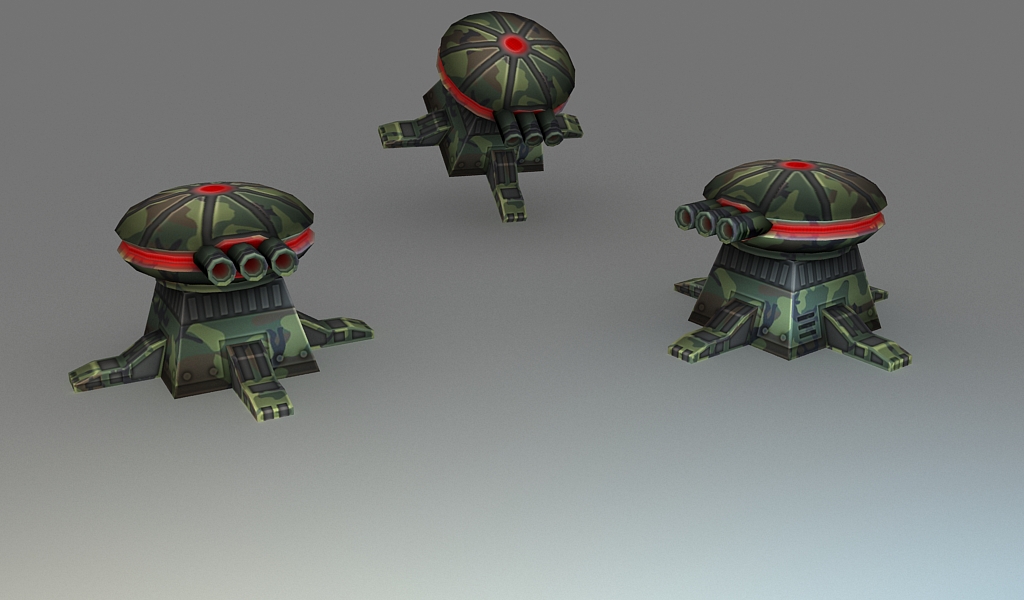

1.c. Tunnel puncher
The most powerful robot among all. No garnet. No brains. Moves slowly. But power! If there is such a number, and you do not have an electromagnetic grenade or powerful explosives - it is better to run. And as quickly as possible. If such a poor minion knocks on the head, a wet place will remain from the minion.
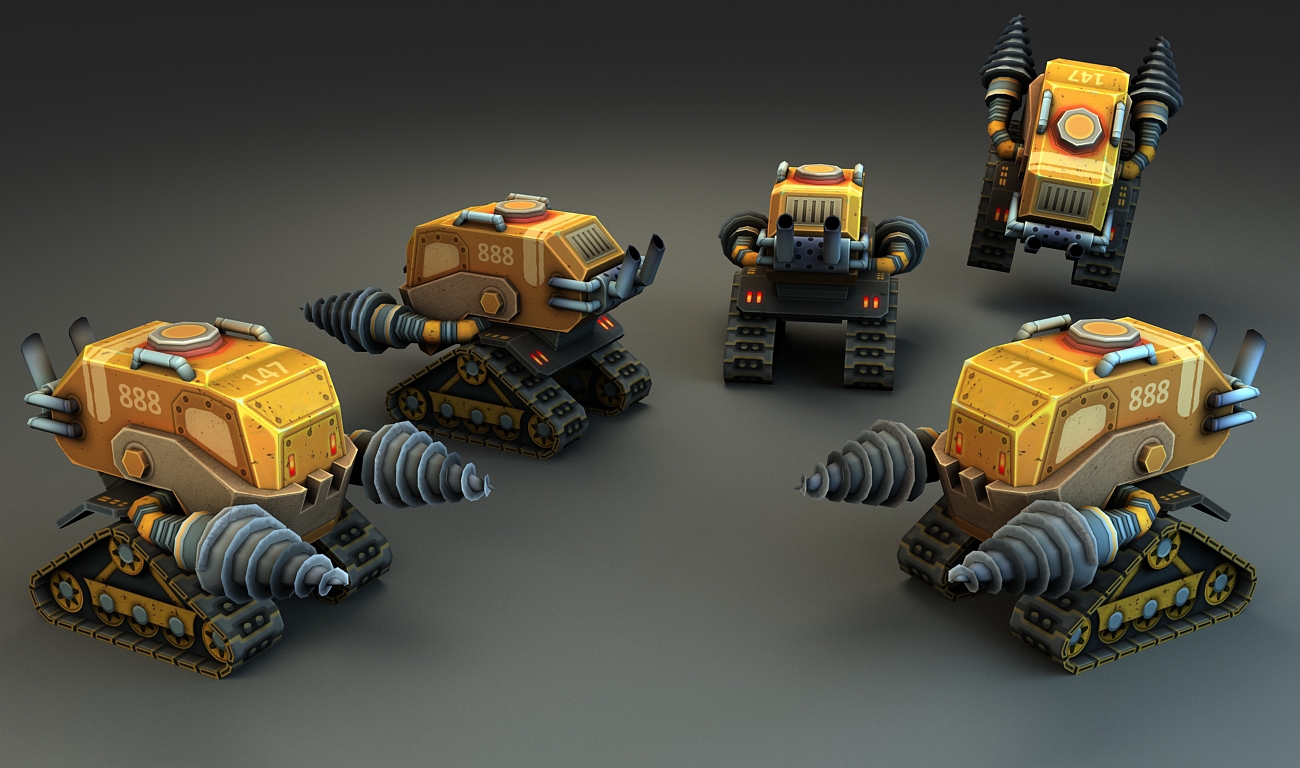

1.d. Fighting robot
Latest development. With all the pluses. Paired reinforced grenade launcher on the shoulder, protection from electromagnetic pulse, microreactor in the belly. Terrible opponent, but very much like to throw grenades - shoot, happened, and rushes to rapprochement. To his own grenade. It is good that the supercomputer is not friends with logic ...



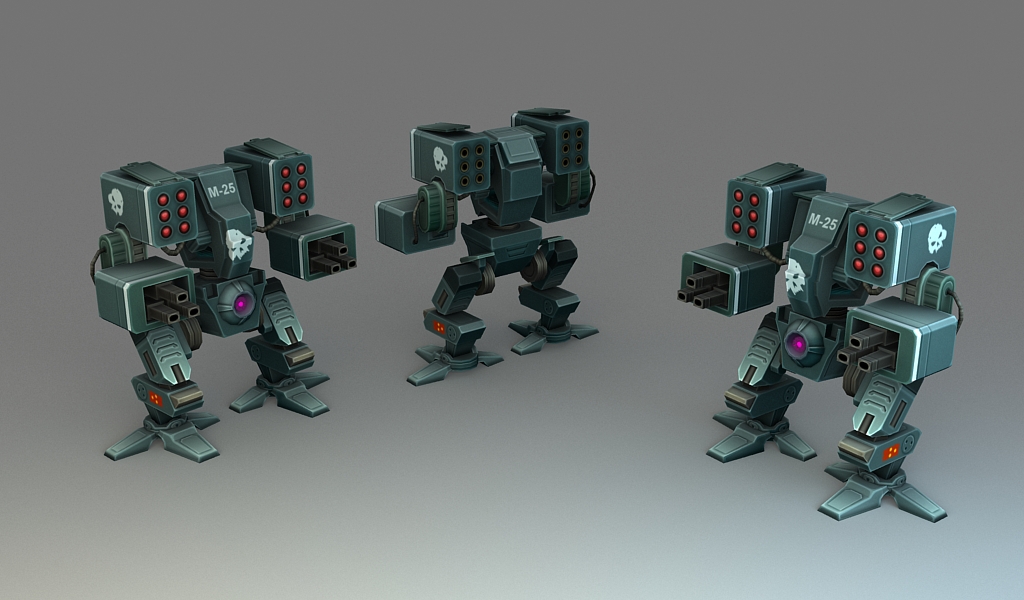




Boss. AI (artificial idiot)
The powerful computer after the destruction of the base has lost a significant part of its logical blocks. Figuratively speaking, he turned into an old schizophrenic psychopath who sees his worst enemy in any being. AI managed to keep under control one of the production workshops with the infrastructure that had survived with it, through which from time to time it releases all new batches of robots, and until it is stopped, the computer is invulnerable. In addition, it is completely protected from electromagnetic impulses, thanks to its excellent protection. But a nuclear bomb may well finish off the old car.

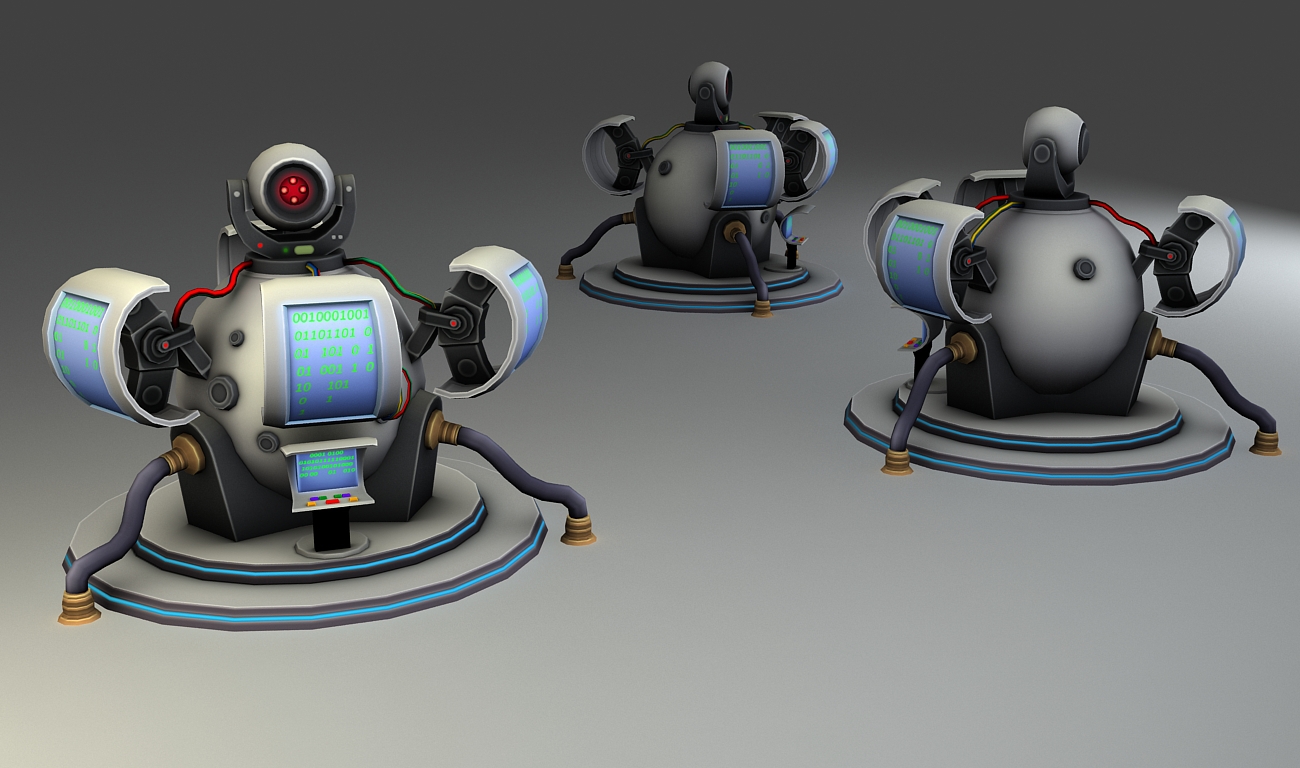


2. Zombies
As every evil genius should be, Professor Kopatel had a pet - a hamster named Boo. When he died of old age, the professor did not get himself a new one, but began experiments on revival. Naturally, the experiments were crowned with success and the giant space hamster (he looked like a normal one) came to life. Only here the strain of the virus remained in the laboratory and after the destruction of the base broke free. And it would be okay if he simply revived the dead ... Either the virus mutated, or some other actions were required to complete the resurrection, but the animated dead rose from their feet with brainless stray remains, guided by simplest instincts. The most important such instinct - the search for food. It turned out that the surviving professors minions turned out to be the main sources of proteins, fats and carbohydrates, so the zombies, which can be burned or blown up by a powerful bomb, became a great nuisance. The only advantage of a zombie is absolute stupidity and extremely slow movement.
2.a. Zombie hamster
Hamsters are the most common species of the walking dead in dungeons. And the most frail. They bite badly, they don’t run too much, they die from any grenade ... But there are a lot of them.

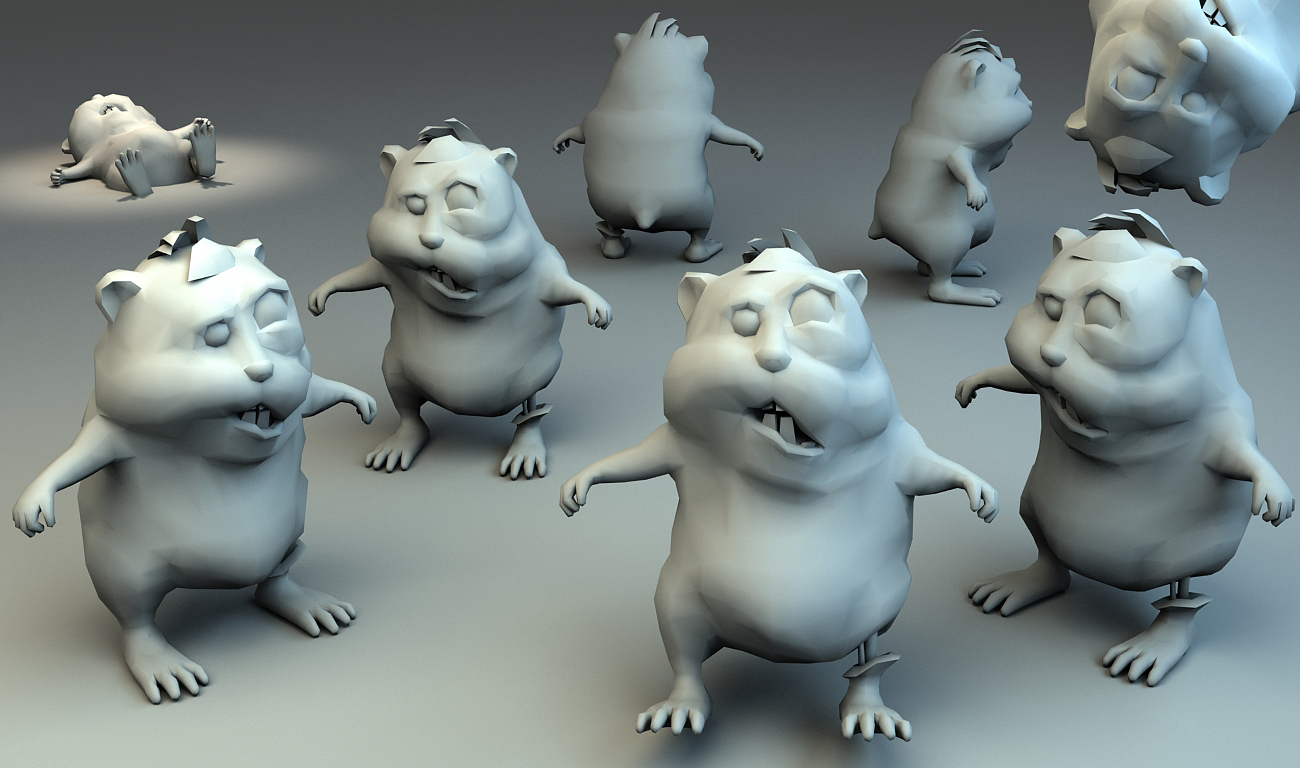
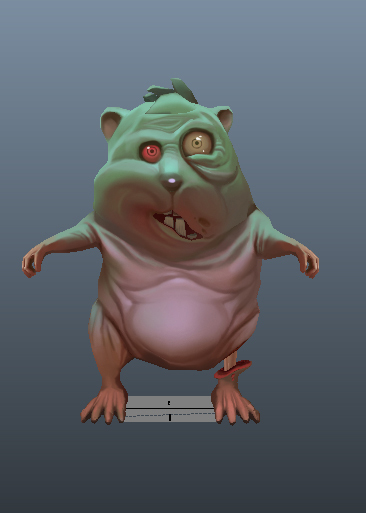



2.b. Revived cat
One of the most dangerous opponents is the undead cat. Fast and agile, this creature can bounce at the moment of attack, which makes it a very strong and dangerous opponent. Well, that cats are easy to blow.
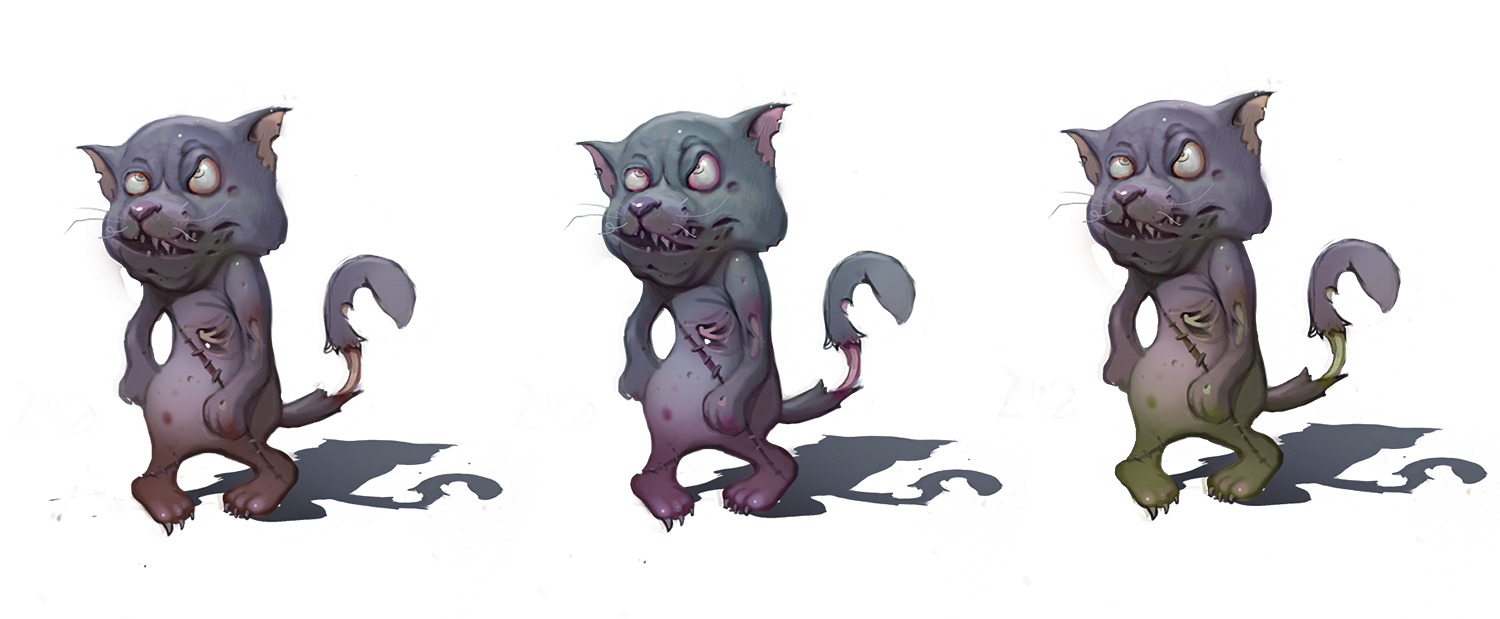
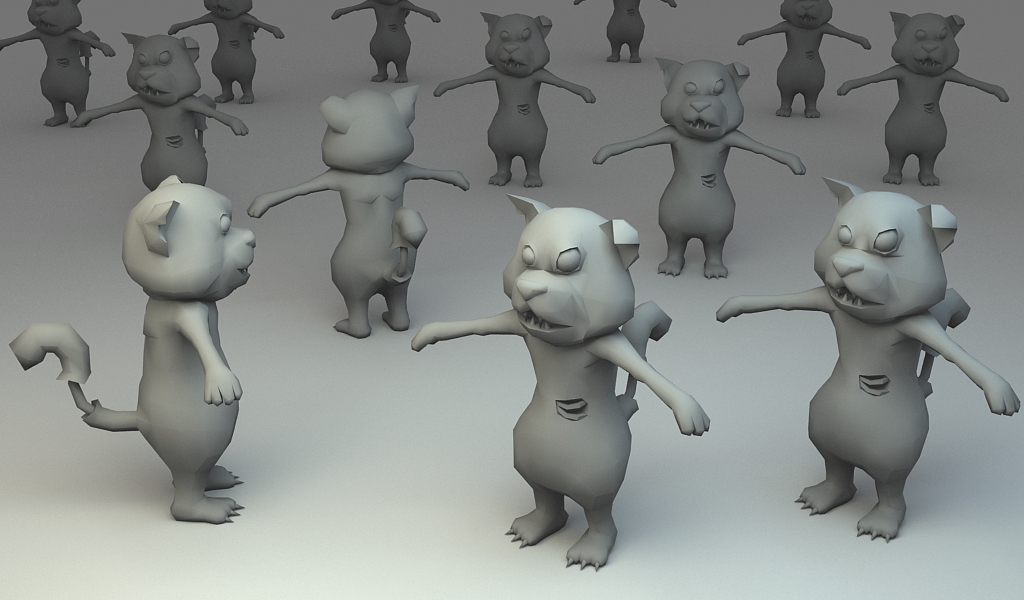




2.c. Zombopez
Dogs are different. But in the dungeons, only fighting rocks are usually found, so that the youngsters have to be on their guard. Zombops are slow, but have high survivability and strong attack. And they often gather in packs
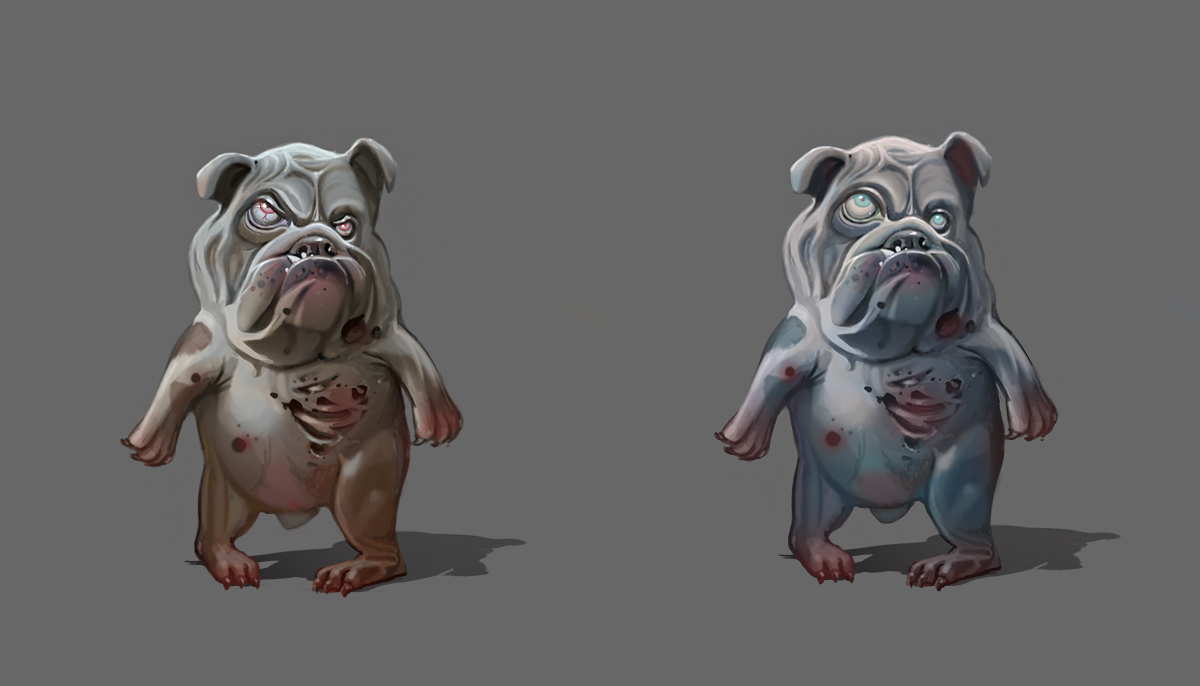

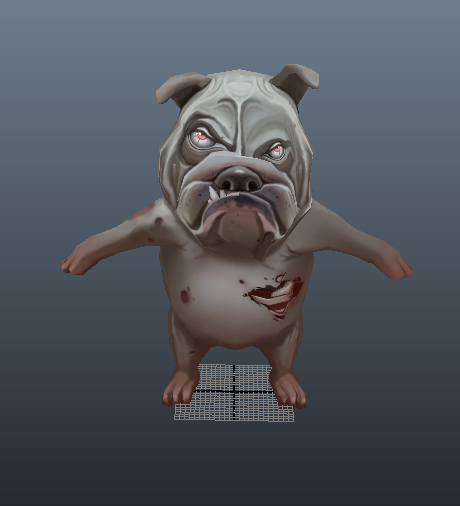



2.d. Ratfish
Rats have always lived underground. And when the first of them began to return to life, a war broke out between the living and the dead ... In which the last won. There are very few rats left, but each of these individuals can easily destroy a whole squad. Super high speed, unexpected attacks, intelligence developed by the standards of zombies ... Add to this the flow of poisonous mucus after destruction - and you will get a deadly enemy.
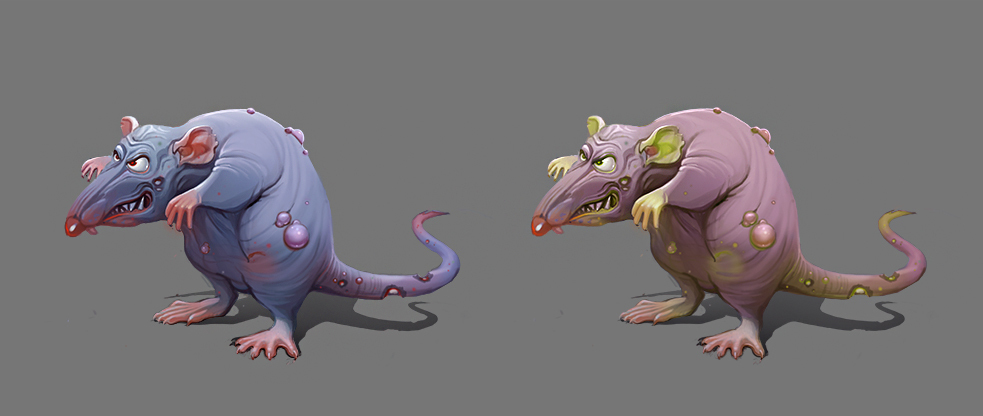
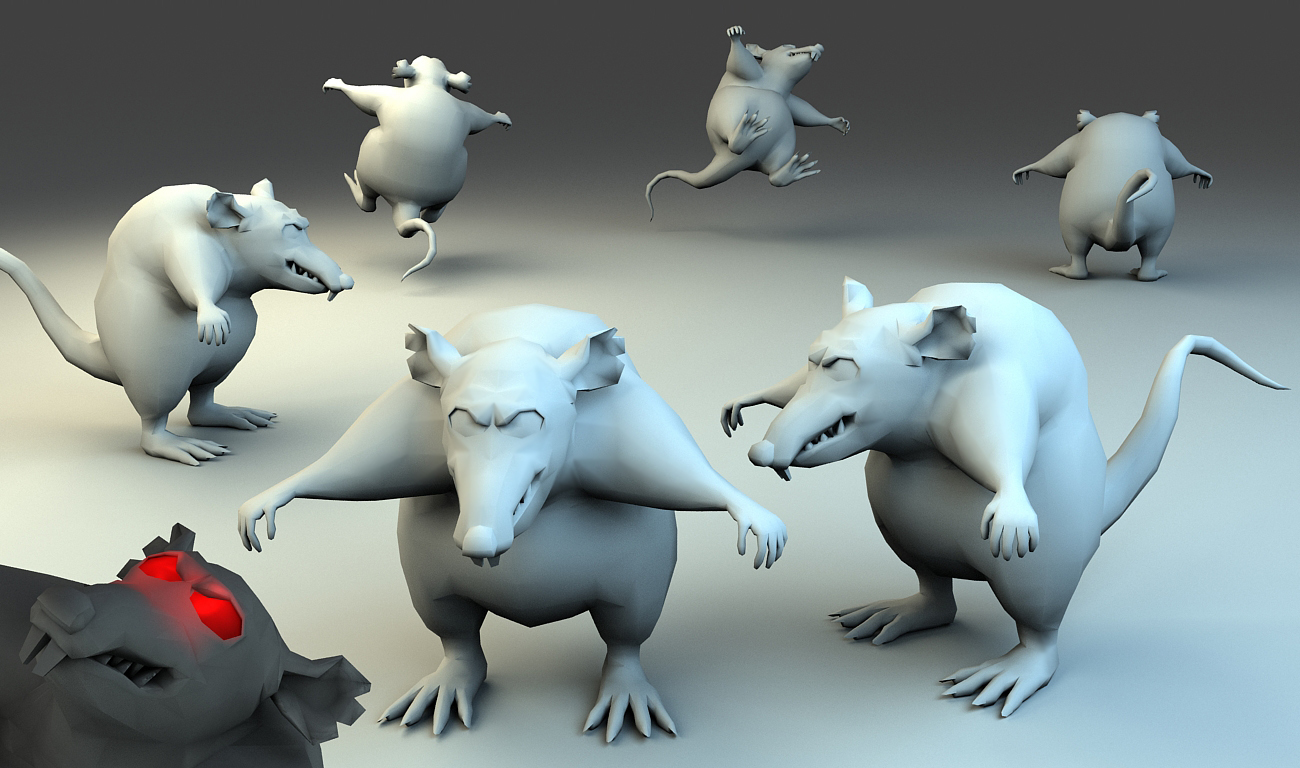
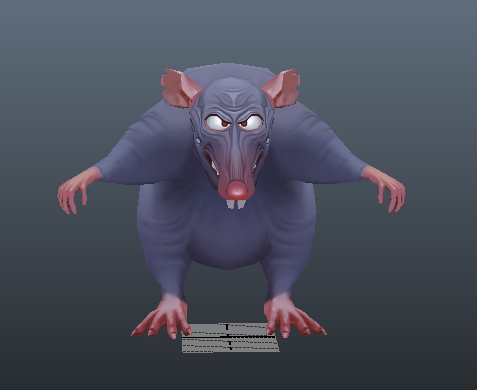



Boss. Zero patient
One of the first accidentally living dead acquired over time the greatest power. And without that, it is not quite adequate, the zero patient received control over the army of zombies. Yes, they are stupid, but who said that they cannot inspire commands? Having stayed in a remote corner of the base, this revived corpse controls a large army of the dead. Ways to kill him are still unknown.
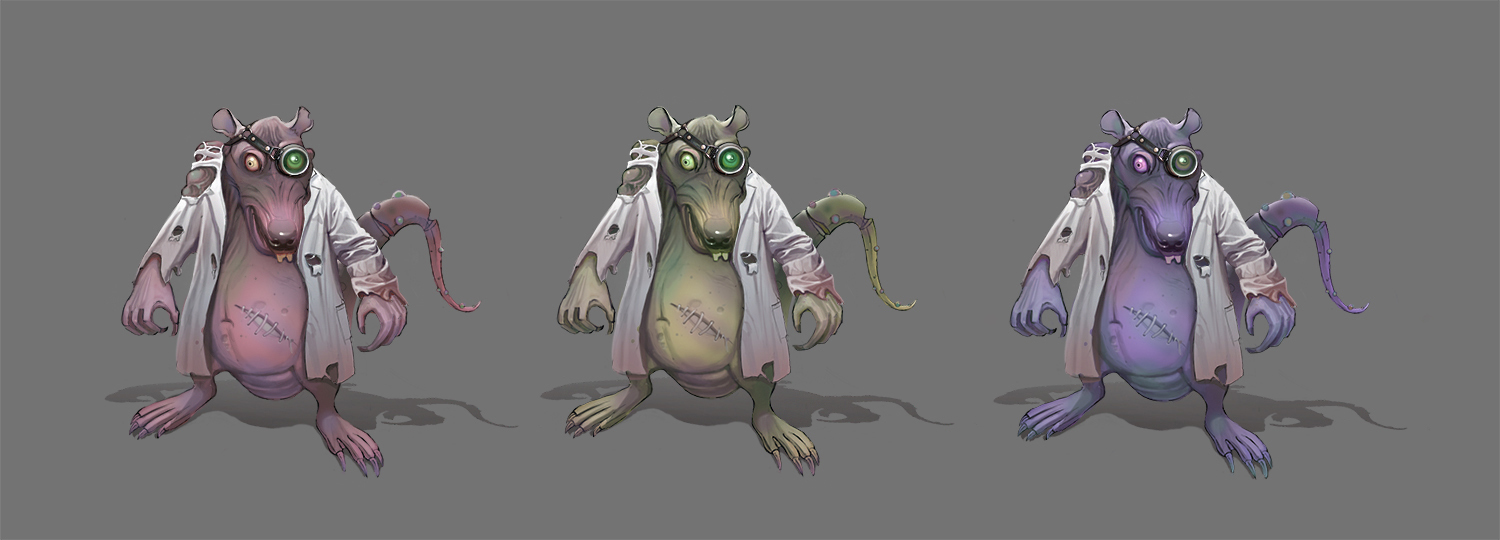
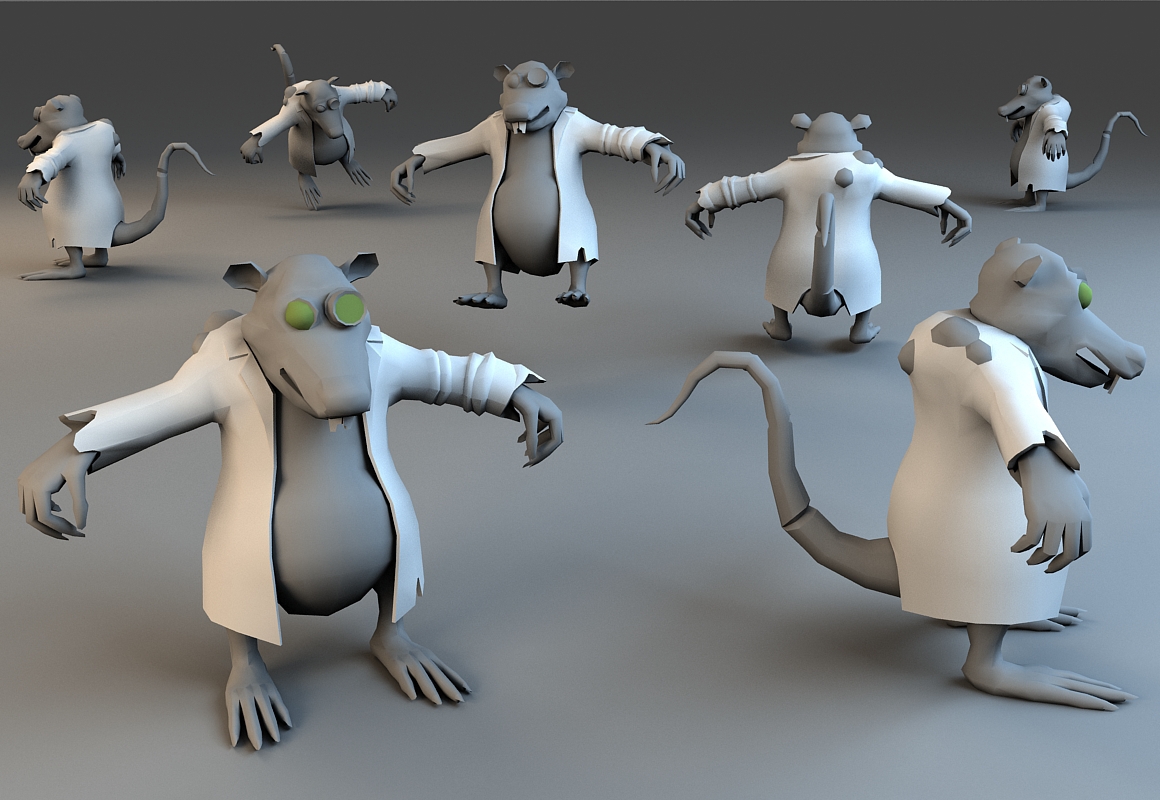
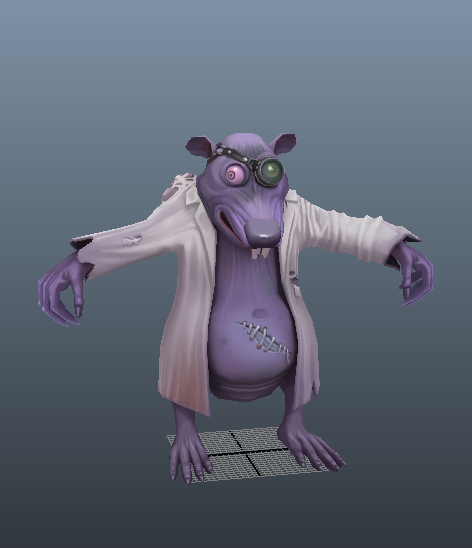



3. Stone Golems
Silicon virus was supposed to be the greatest discovery of Professor Digger. A stone that can take any desired form, harden in it, and at the wave of the owner’s hand, change it - what could be better? But things did not go as planned. The virus was mutated and when exposed to certain volumes of the stone, the latter began to acquire the mind. More cobble - higher intelligence. The biggest problem turned out to be that the golems were curbed by the only desire — to become the immovable stone again, to fall asleep deep underground and not wake up. And how can you fall asleep, when the minions always blow something up, zombies go around here and there and grumble something, crazy robots throw grenades far away and clang their limbs? Therefore, living stones all the time violently attacking everything that they come across. Fortunately, all the golems are afraid of explosives - although they are hard, but extremely fragile, they are not collected again after scattering into pieces.

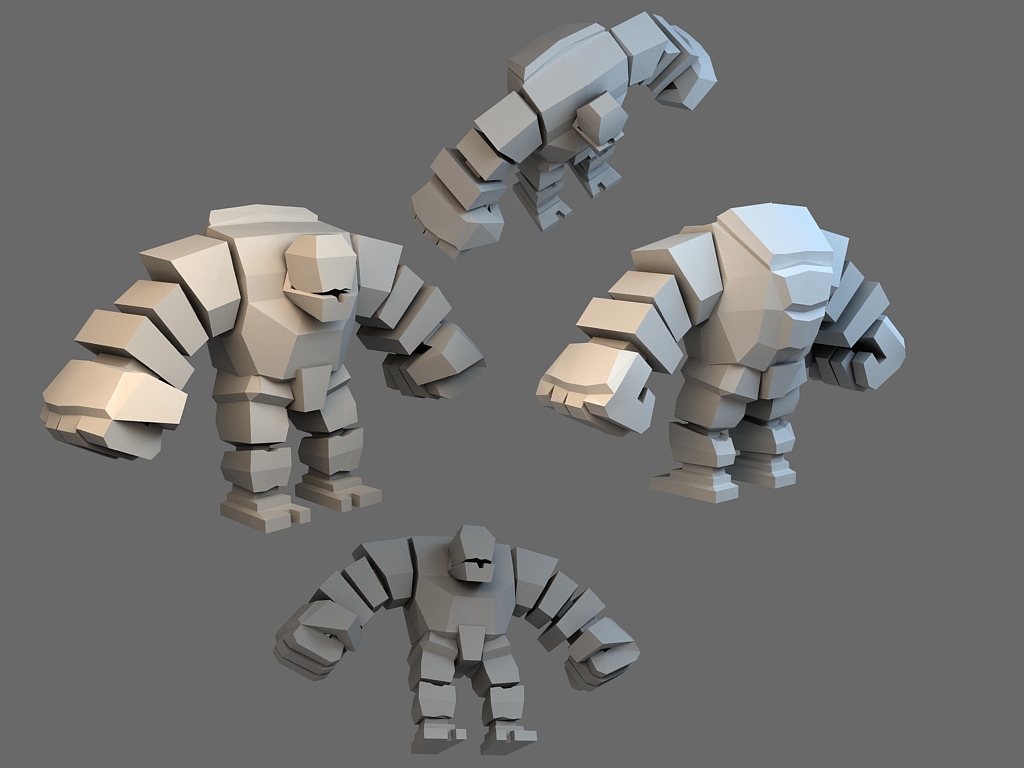



3.a. Sandstone golem
Sandstone is the lightest rock. These golems are slow and weak, and the fragile body is easy to explode. The main thing to remember is that all golems are insensitive to fire (some assume that it also heals them) and all golems can make their own tunnels.
3.b. Lime Golem
Limestone is much stronger than sandstone and golems from it are much more dangerous - they move quickly, beat painfully and are difficult to kill. Try to destroy them one by one and use powerful explosives.
3.c. Marble Golem
The marble golem is very strong and very strong. It can only be destroyed by a nuclear bomb or the Bishop bomb. But he is so slow that it’s easier to get away from this golem than to try to kill him.
3.d. Granite golem
Granite golems are the most dangerous opponents you can meet. They are fast, durable, and their attack will easily kill an unprepared researcher. If you see such a golem - try to leave it aside.
Boss. Lava lord
Consciousness is gaining strength with size and Lava Lord is the largest reasonable piece of stone in the world. The silicon virus gradually reached geothermal stations immersed in magma. The molten stone turned out to be an excellent carrier - a huge golem in itself is a rather formidable fighter, but he also has a highly developed intellect! Add here a temperature of a couple of thousand degrees and get a decent opponent. Unfortunately, a semi-liquid stone cannot be destroyed by explosions and especially by fire, so the victory over Lava Lord is a very difficult question.
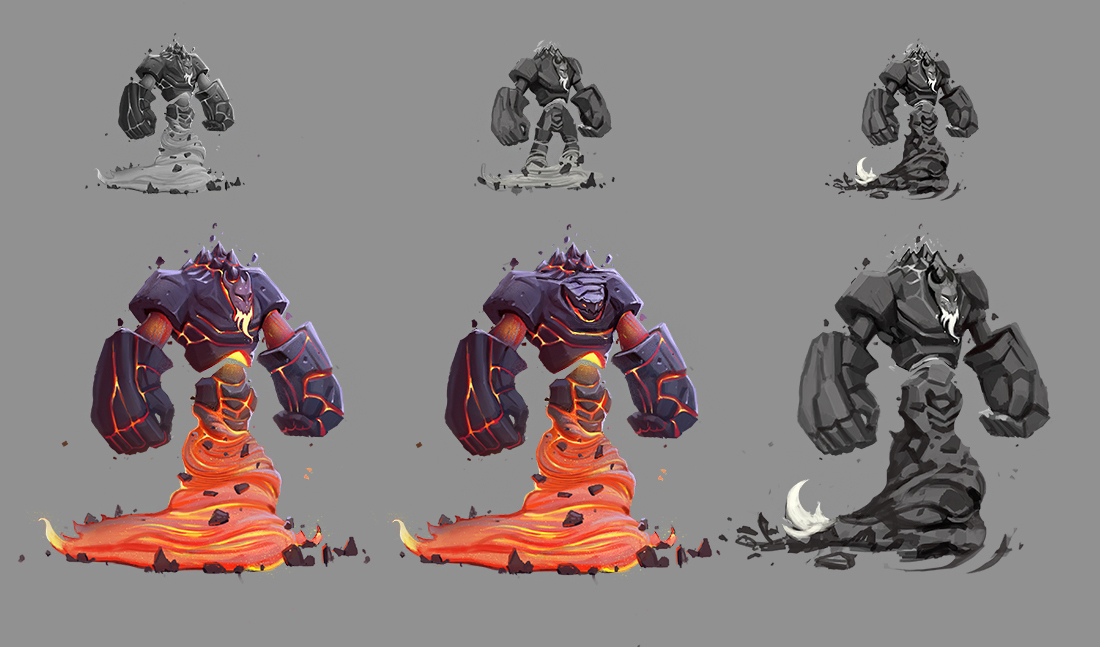
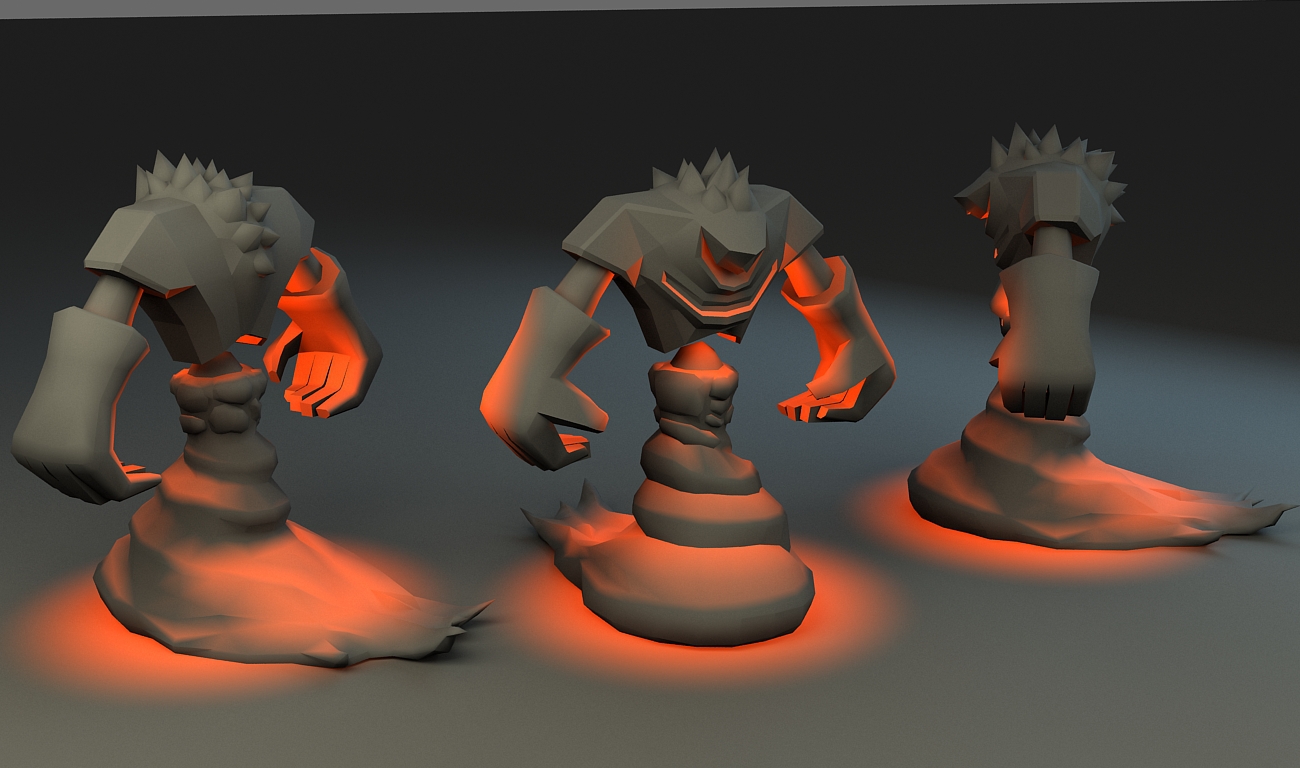




4. Slugs
Initially, protoplasm was designed to clone minions, but after an epic battle, it received radiation exposure and began to grow rapidly. From time to time, bumping into foci of radiation, mucus received new mutations, which led to the appearance of slugs - dull lumps of biomass, with rudiments of sense organs. These slugs completely ignore any explosives, but they are very afraid of fire. It is difficult to incinerate them, but frying is very easy. The most important thing is to destroy the source itself, which all the time will generate new and new slugs ...
4.a. Light green
A newly degenerated slug is not dangerous. Able to digest the body, but very much too slowly, a flamethrower is burned in a matter of seconds ... Although, a pack of dozens can devour a gaping minion. An explosion on such slugs does not work at all.
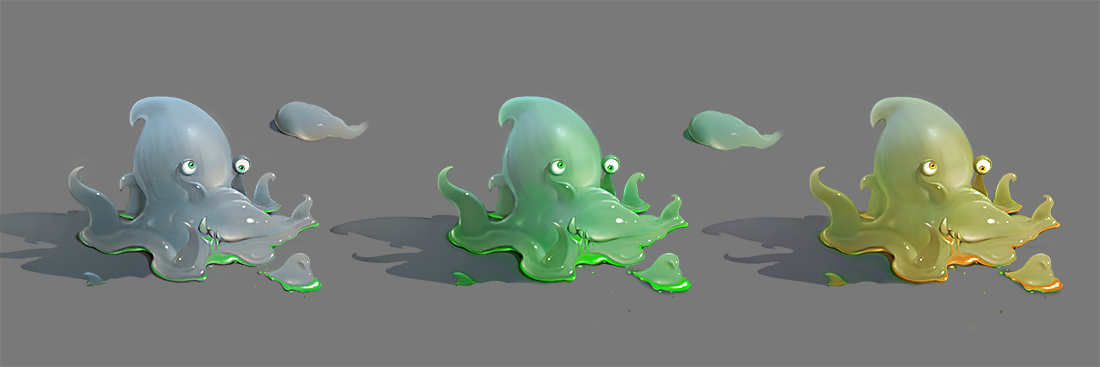



4.b. Green
When a slug devours a couple of zombies, he will acquire a deeper green color. Its digestive juice becomes more caustic, its speed increases, as does its size. Such slugs are more dangerous, but they are also easy to destroy.
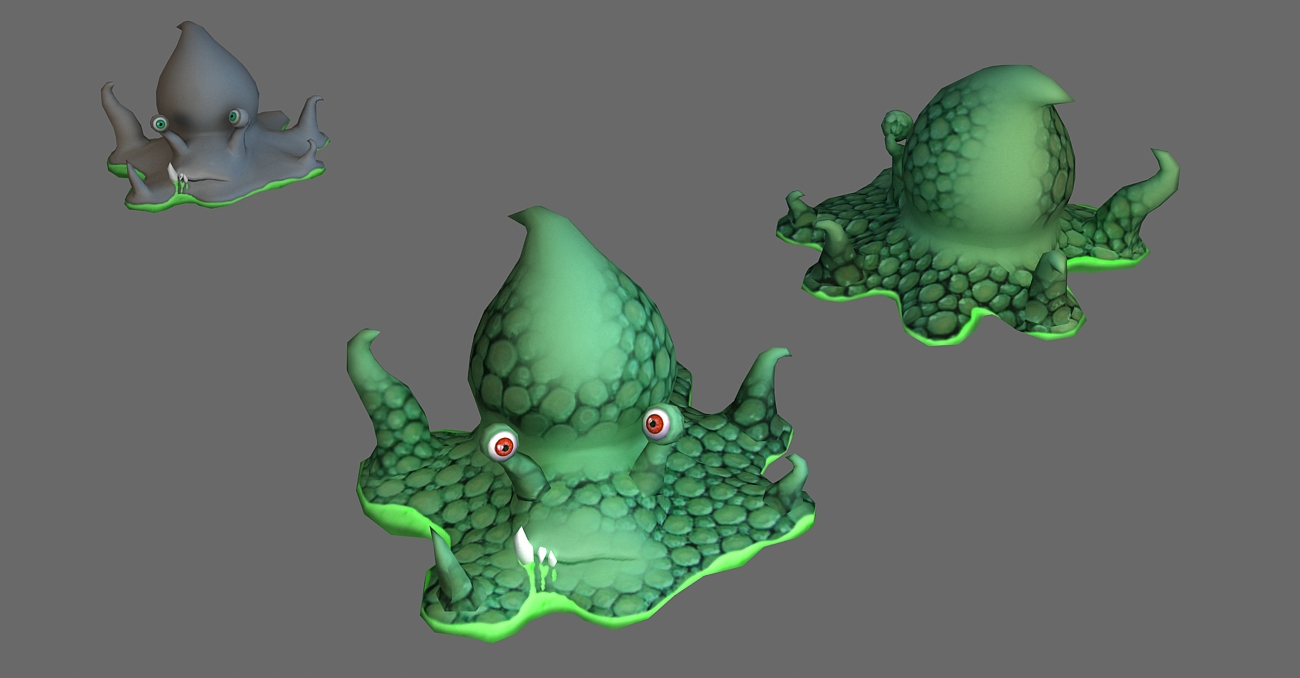

4.c. Transparent
Many slugs are completely transparent. They do not move, but lie in one place in search of a gaping minion or zombie. Very often valuable objects lie inside such a slug - they care nothing for gastric juice, and if they get into this, they will not let the victim go. The only way to free yourself is an explosion, but after it the slug will come together again. Therefore, always wear a flamethrower.


4.d. Slug carrier
Some slugs form a colony - the young get inside the green slug digested and in this form travels through the dungeons. Juveniles are quite capable of getting into remote places in search of food, while a stronger carrier protects them from the external environment. These are especially dangerous - after burning the carrier's corpse bursts, spewing out a number of new slugs.






Reasonable Slug
One of the slugs once managed to stumble upon a large cluster of zombies. They could not kill him, of course, but he, in turn, was happy to have a snack with brainless carrion. The future Reasonable Slug, who had grown to a completely indecent size, advanced further down the evolutionary ladder — he learned how to collect the remains of space suits, clothing, equipment, and even furniture on his body, acquiring original armor. In addition, this creature is able to pull out of itself a flock of ordinary slugs, which, after eating, replenish its strength. It is very difficult to kill him - an explosion only scatters his body to the side (and then it will assemble), and the slug is securely covered with armor from fire.






Basic gameplay and GUI
Another prototype revealed a problem with control. Too many weapons (about 20 types), and only 2 buttons to switch them. Yes, and where does a small Crotan even have so many weapons in your pocket? Although the characters we have and cartoony, but the environment of Hi-Tech. Therefore, it was decided to release crotan to levels only in a special pumped exoskeleton, the main feature of which was the presence of a weapon printer, so that it could quickly create any bombs to choose from the available materials, rather than carry them with them. Also, 6 types of materials (metal, plastic, electronics, explosives, fuel and uranium) from which one could make bombs were put into the game. The bombs themselves were divided into 6 groups according to certain criteria. And those that stood out much made class. Yes, this is where the class tree came in useful.
A brief description of the setting and plot can be formulated as follows:
The battle between good and evil ended in a crushing defeat of the latter. The combined forces of superheroes dealt a crushing blow to the den of the supervillain. Its underground base has been severely damaged.
You are one of the surviving, loyal minions. You must find and save your fellow survivors. Become their new protector. With this you will be helped by one of the remaining working exoskeletons of the MGE-OP-14, in which you can clear the remnants of the base from the monstrous experiments of its owner that have broken free.
So, restore the base and retaliate !!!
Creating objects and characters
This part is unlikely to be a discovery for someone, but still I will explain how the work on the 3D game looks like. You have a list of objects you want to draw. The screenwriter and / or ideological mastermind, knocking fingers over the keyboard into the blood and working with the mouse until the power cable is worn, collects refs (pictures, photos or video of what the object should look like) and give it to the artist. Of course, you can not search, but limit yourself to a dry description of two words, but then you can expect anything from an artist. In general, remember, a telepathic artist is a rare, almost extinct creature, so take the trouble to explain to him what you want from him.
The artist draws a concept, and shows it to those who are deprived of artistic abilities. After several shipments for revision, the modeler takes over. A good modeler needs just one concept. Give less experienced and in front and in profile. The model can be high poly or low poly. Respectively high and low polygonal. And, interestingly, good lowpoly modeler beast is more rare and valuable than highpoly. In addition to the model itself, it must also marshall it (i.e., create an empty texture-blank, something like a sewing pattern) and give it to the texture maker. The text leveler naturally makes the working texture so that the model looks like concept art (in addition, it can throw a normal, a dump, a speculator and other mapy). Then, ideally, the model is transferred to the rigger that creates the rig, i.e. the skeleton of the model, and the engraved model is transferred to the sensitive hands of the animator. As a result, the programmer gets the model, textures, animations and inserts them into the game.
So, a concept artist, high- or low-poly modeler, text level maker, rigger, animator. At least 6 professionals are needed to create art for a 3D game. Of course, some tasks can be combined and confined only to an artist, modeler and animator, but still this is a lot compared to 2D games, where you can do with just one artist;) Examples of how our characters were created are contained in the spoilers above.
Fortunately, we were lucky with both the artist and the modeler. Both were professionals in their field. But the animator did not have enough money. What I regret, of course. But we were lucky, because The Mixamo service, recently purchased by Adobe, has come to our attention. I advise it to all indie developers for several reasons. Firstly, it allows you to buy already shattered 3D character models. Secondly, the animation to them. Third, it allows you to upload your models with a rig, animate them on the site and buy the resulting animations (moreover, such parameters of these animations as speed, arm span, level of hand position, etc. can be calibrated). Fourthly, if you only have a model, then you can try to use the authoring Mixamo. Moreover, it works quite well with humanoid models. Unfortunately, the humanoids among our characters are few, so most of the rigs were ordered from a freelancer, but the service itself showed its best.
For example, we decided to add a small hand-to-hand fighting game to our game, while it took only 2-3 days to create animations and a tree of behavior of Mecanim, and this was due to the abundance of enemies.
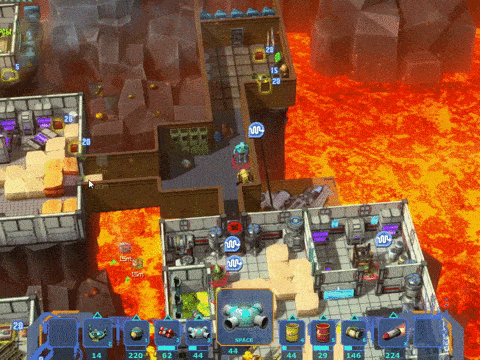
A little tip. About fake screen
If you have an artist and the project is not quite primitive, then spend a few days creating fake screen, i.e. gaming pseudo screen so that all team members imagine the end result. Place there the main objects of the environment, the hero, if that is the interface. It will save you a lot of time in the future.
Here he looked like this:

But the final result
Screen 1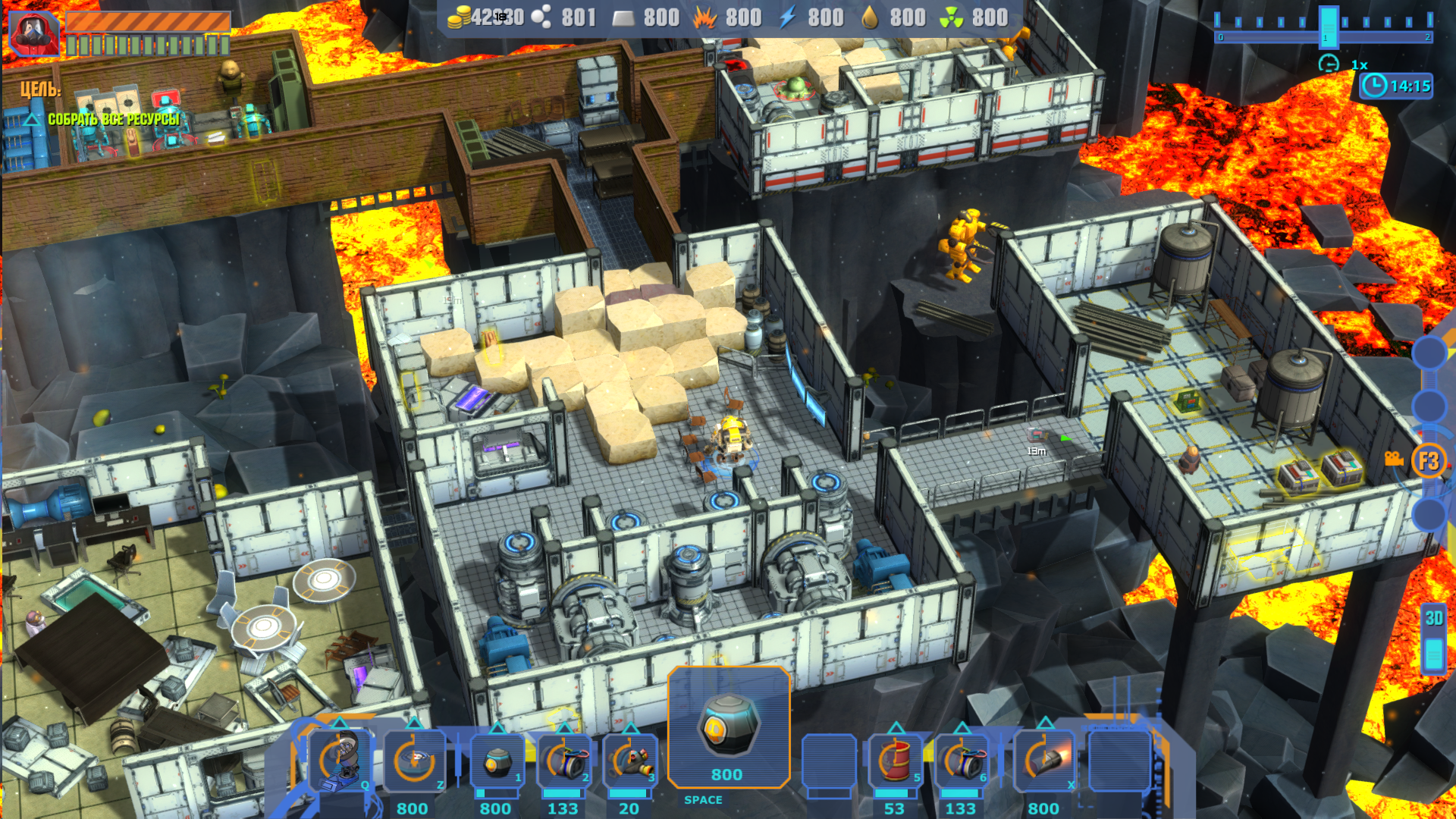

Screen 2

Screen 3

Screen 4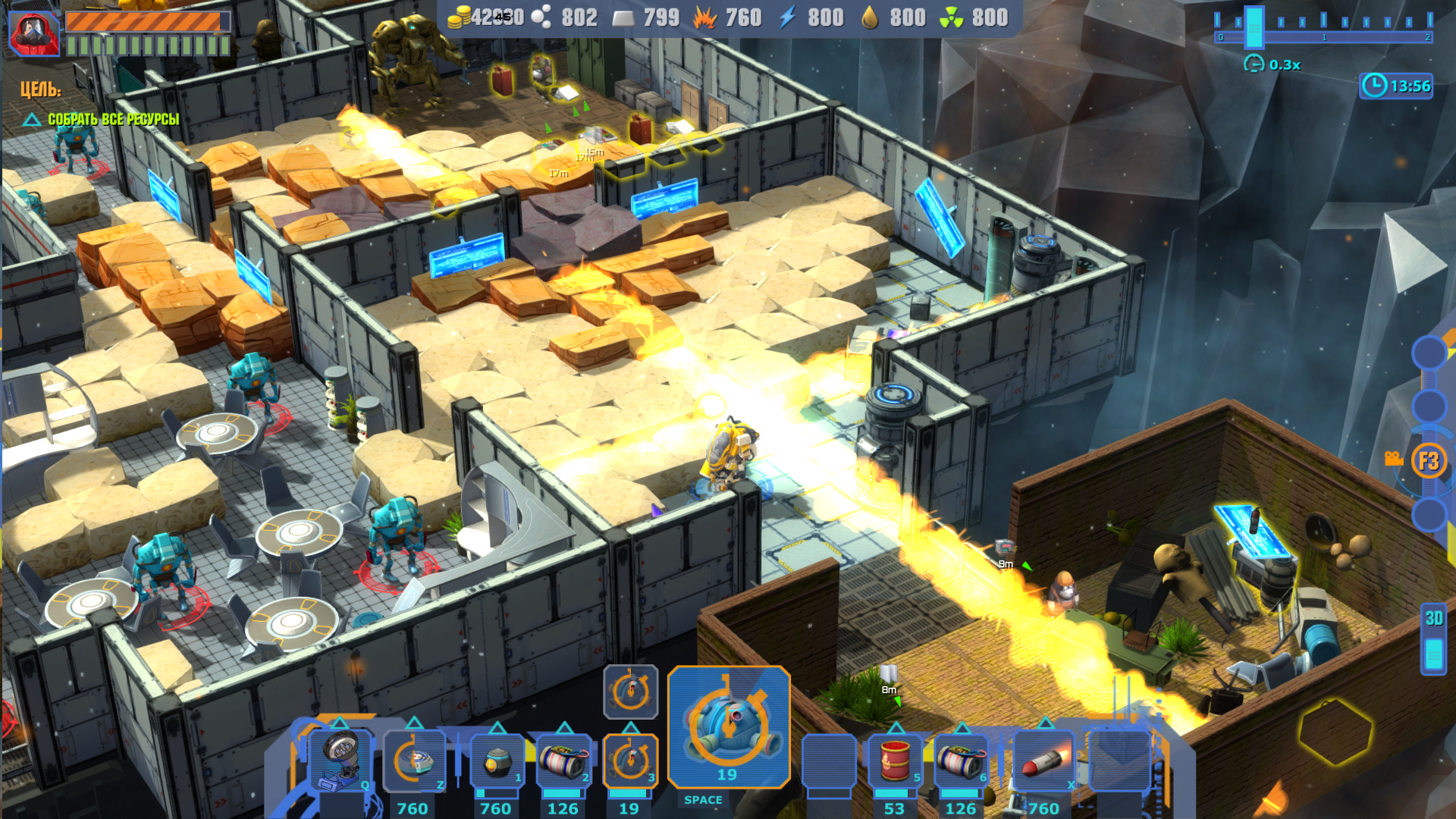

Screen 5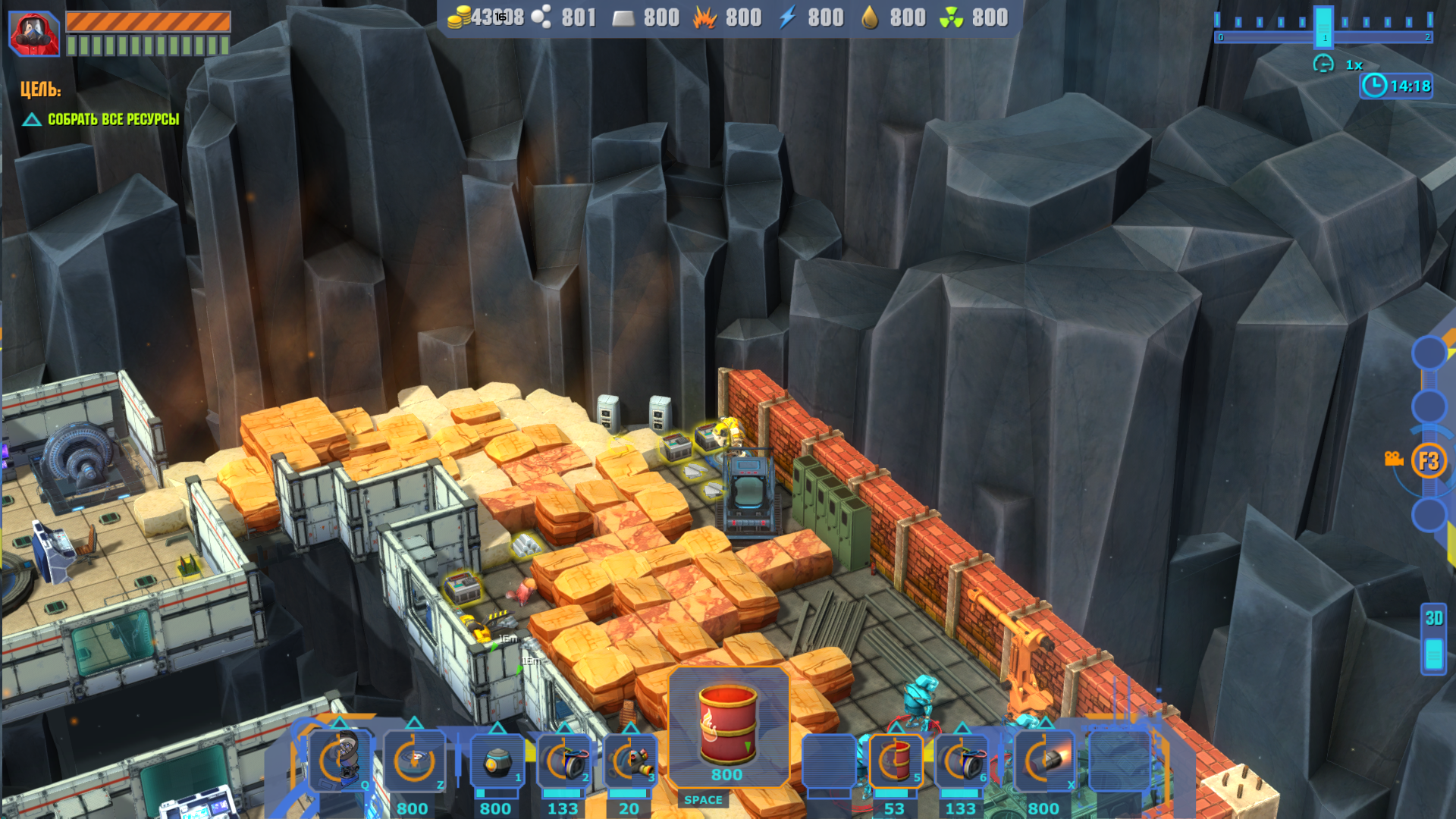

Screen 6

Screen 7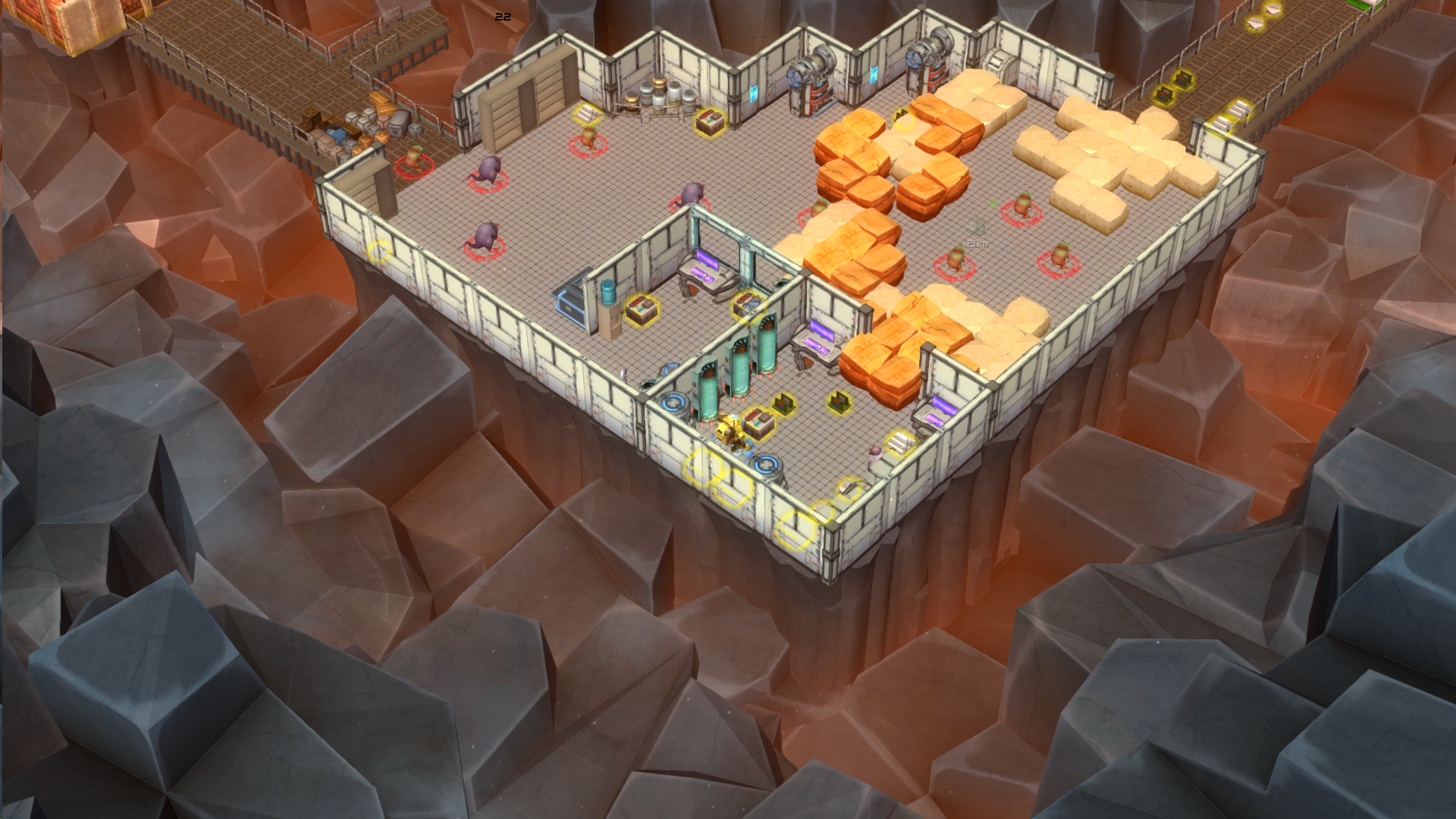

Classic mistakes. Unnecessary chips that are not included in the game.
Pixel-Art mode
Initially, there was the idea of displaying a minimap of the level in the form of a good old pixel-art card, with the ability to switch to 2D game mode. So that players tired of 3D bells and whistles can enjoy old school. Initially, as in the original, most of the map was occupied by various rocks that needed to be drilled and blown up.
4 breeds differing in texture, color and strength, and divided by height into 3 types.
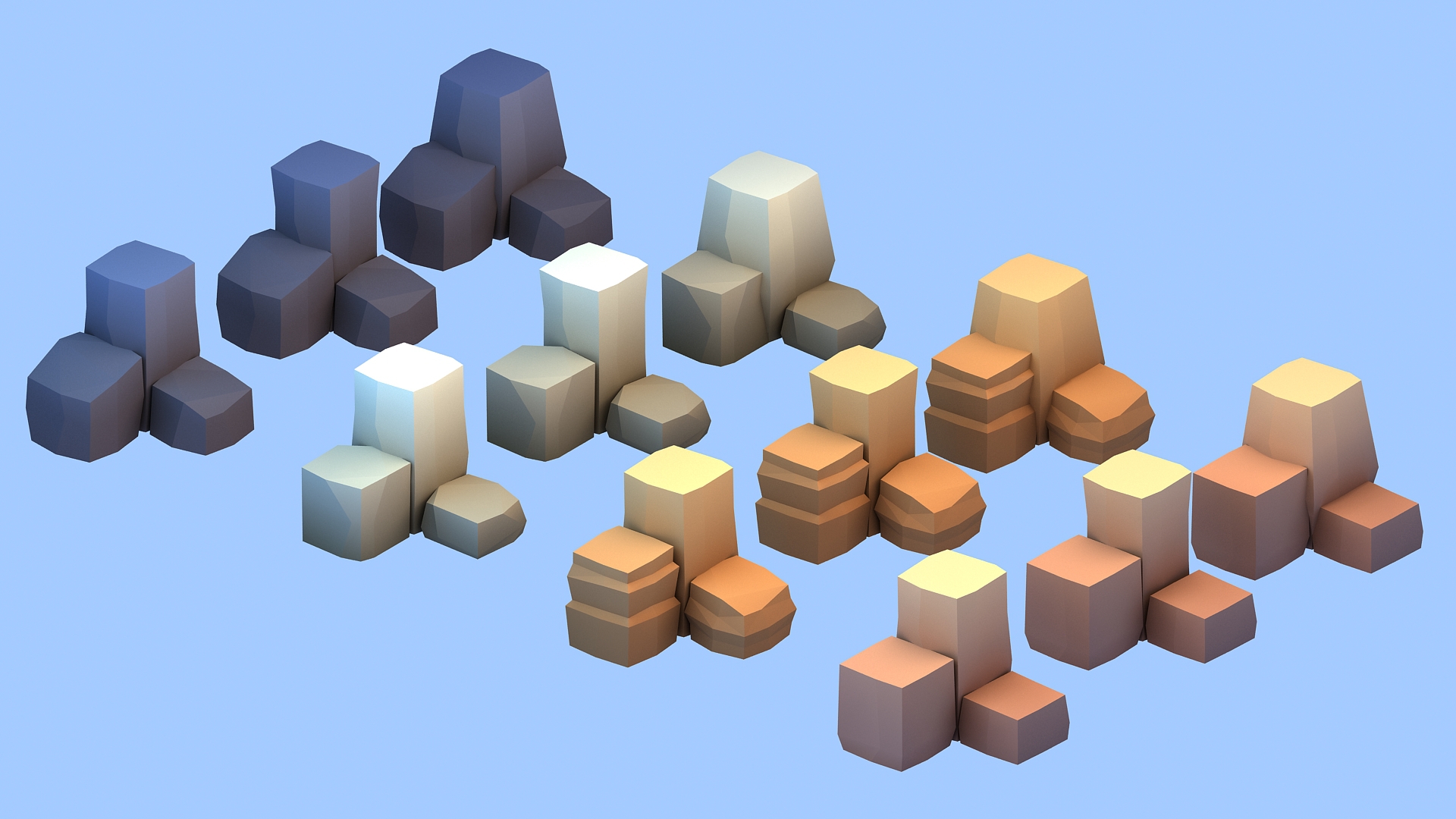
They, along with the other elements, were redrawn in pixel art style (on the screenshot, of course, not all game objects).
Not bad, but something is missing. Volume, to be exact. To make it easier for the player to determine the strength of the blocks, we added to the color and brightness another texture of different size and a falling shadow of different lengths. Those.tall blocks gave the highest shadow, while if it fell not on the ground, but on a block of medium or low height, then its length decreased. At the same time, the shadow falling diagonally looked best, and therefore stones of different heights could be below and to the right of it. In general, you understand that drawing several thousand sprites of the card itself would add a few thousand more shadows of sprites, rendering the height of neighboring objects and all this would take away a lot of CPU time. Therefore, a special shader was developed to transfer all these calculations to the GPU. As a result, on the basis of the current map stored in a two-dimensional character array, a texture was created that goes to the input of the shader and gives such a playing field to the output. And all this for one DC.
To work on these I had to use a couple of freelancers (pixel-art and writing shaders). All this beauty took me almost a month of working time (maybe more, now it is difficult to remember). This includes drawing up the TOR, debugging the shaders, discussing, coordinating and inserting it all into the game. All this corresponded to the original mechanics, where each object occupied one cell.
But then, it was decided to decorate the levels with various decorative elements and add an island structure. To transfer this adequately to pixel art was already too time consuming and did not guarantee a result. Therefore, the 2D mode can be seen only at certain levels and in a very limited mode. Although who knows, maybe it will be possible to make a branch exclusively in this style :)
Server part
The server part has also been burned. Initially, server logic was developed for the original mechanics. Moreover.It was finished and ready for load testing, but after adding decorative elements to levels, there were no resources left to refine the server logic. In the meantime, it was decided to focus on a single game, so that we have pvp in semi-finished condition.
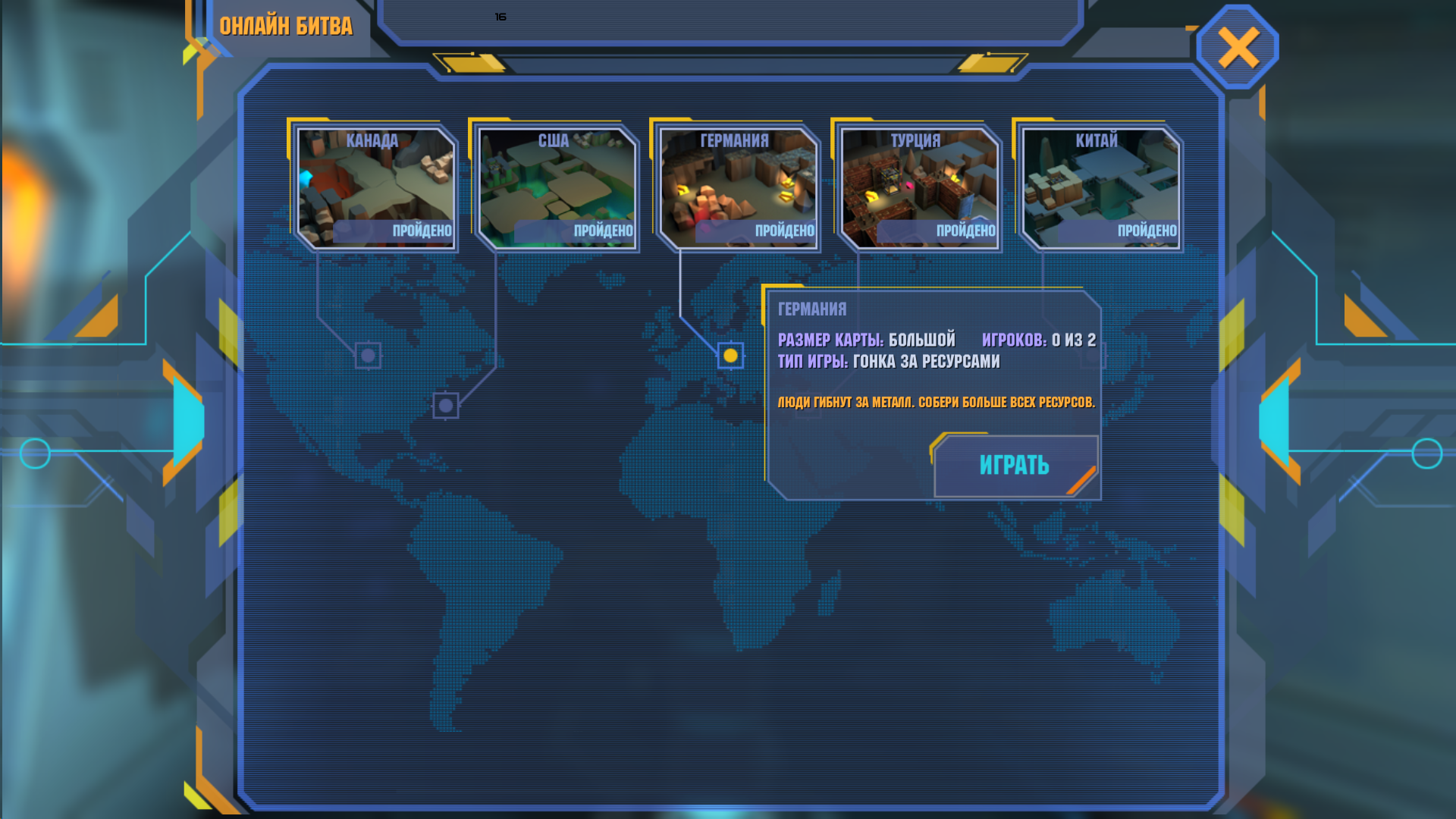
Base location
Instead of a banal GUI, we decided to visualize it as a base location. Only instead of the Normandy from Mass Effect, we have equipped an underground laboratory. When clicking on any device, the camera moved to the screen with the appropriate interface. Not that it was completely in vain, but it took about a month of work of the whole team.

Inevitable evil. Interfaces
The best interface is the lack of interface. Unfortunately in our case it was unrealizable. Therefore, the work on the interfaces took months and this is not a joke. Months of development and implementation. Routine work requiring only perseverance and concentration, which can not be avoided.
Unexpected discovery. Project management is really a job.
Guiding the work of the development team is indeed a job that takes up all working time. If I had the opportunity to return a year ago, I would either find a programmer instead of myself, or someone in the place of a project manager (most likely an experienced game designer). Do not be mistaken that you can easily combine the work of a programmer / artist / modeler and manager. It takes a lot of time from you, and you will not have time to look at the project entirely. Of course, such a manager should have experience in some field, so that if necessary he can back up his colleagues.
Error or not? Breaking bad.
Filling the RPG part of us suffered. After all, we counted not only on the single-player campaign, but also on the constant online battles. And for that, it was necessary to give the players a good leveling capability. In addition to the class tree, the choice of a profession by players opened access to special weapons and skills.
3 classes, 6 subclasses, 19 skills.

Our exoskeleton conditionally consisted of 10 slots for equipment of various types and levels.
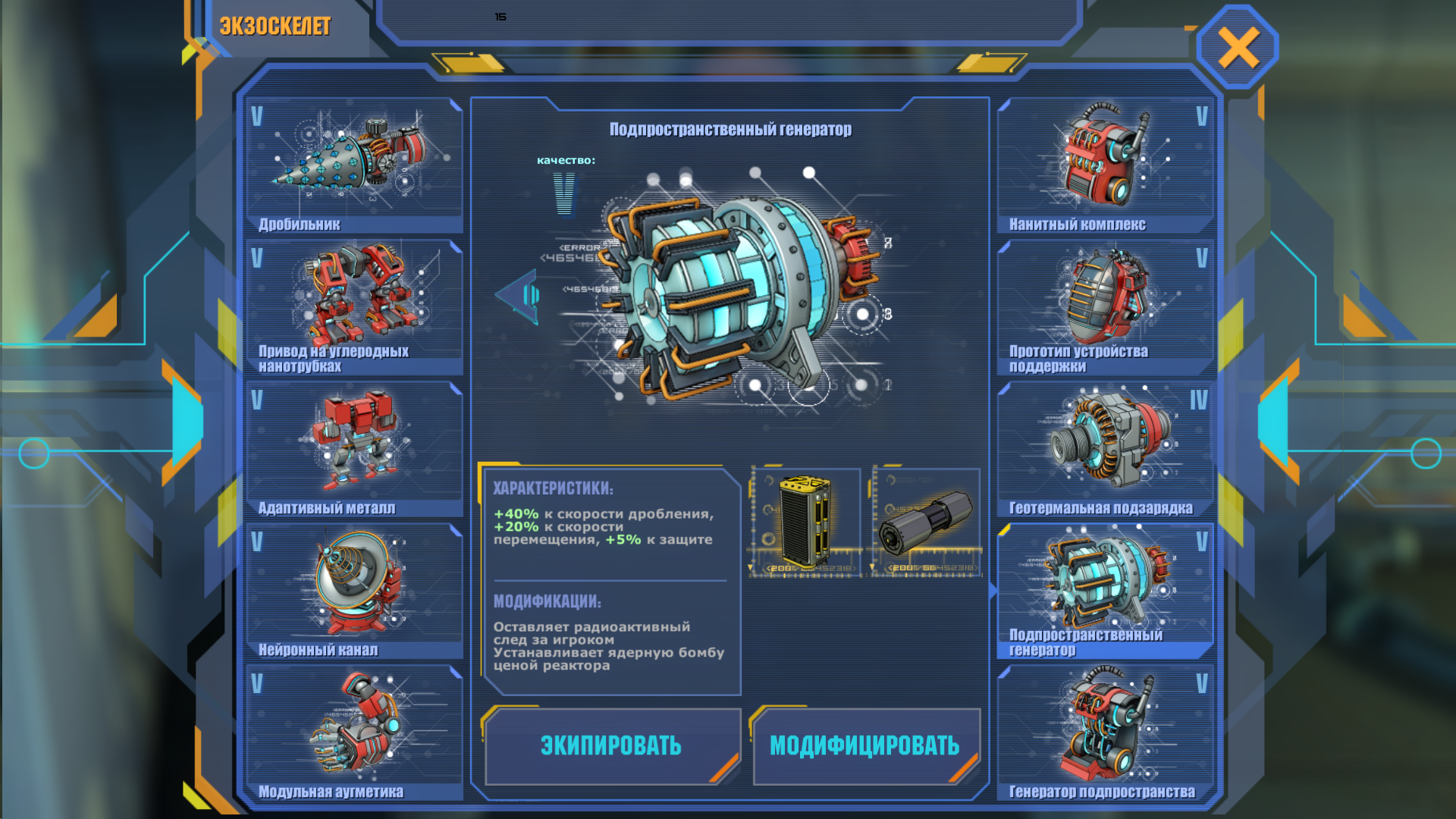
Up to five types of equipment per slot, which could not only be bought at the store, but also produced at the base, after studying the appropriate scheme.
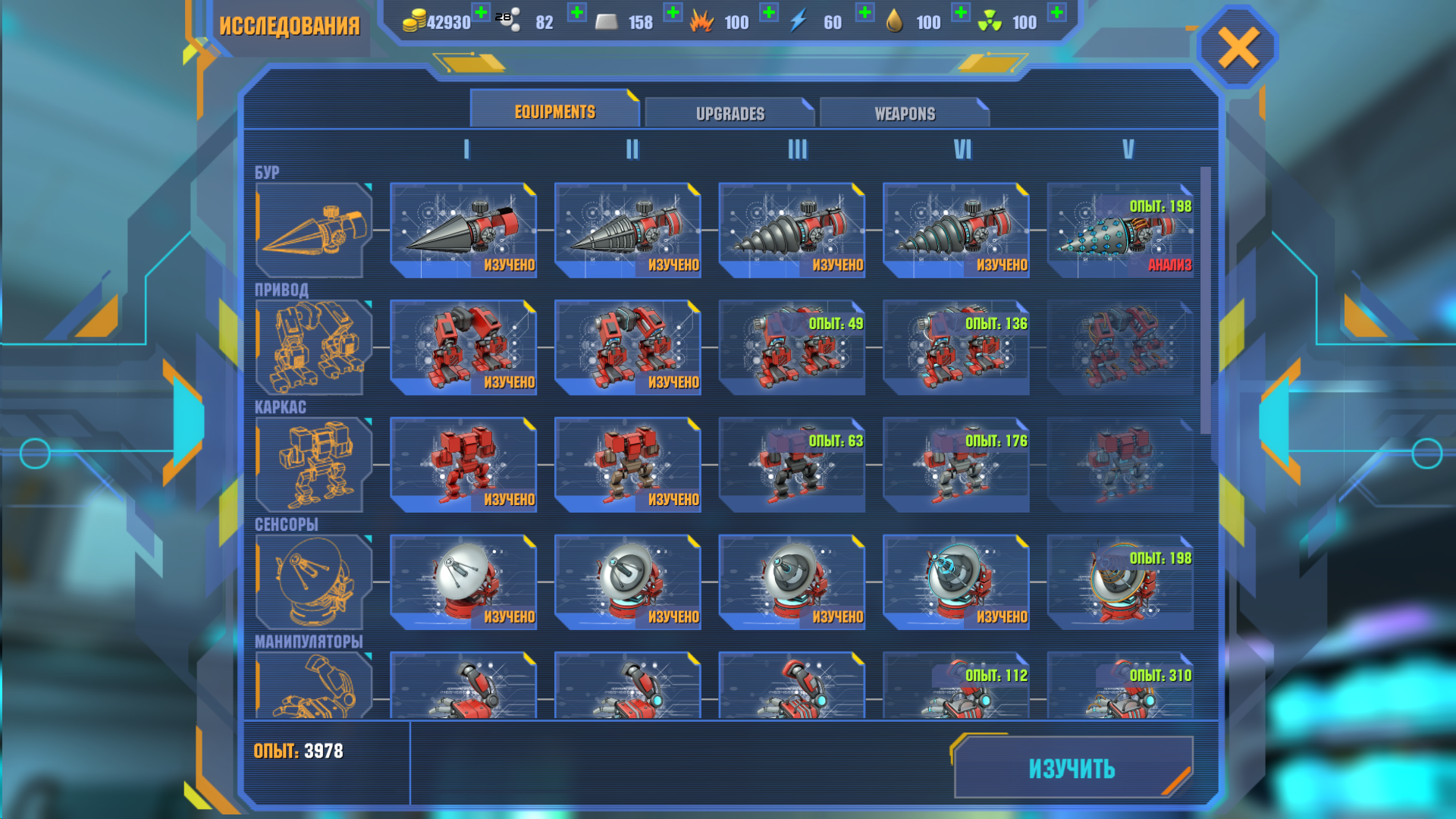
In addition, almost any equipment could be enhanced by inserting a modifier into it.
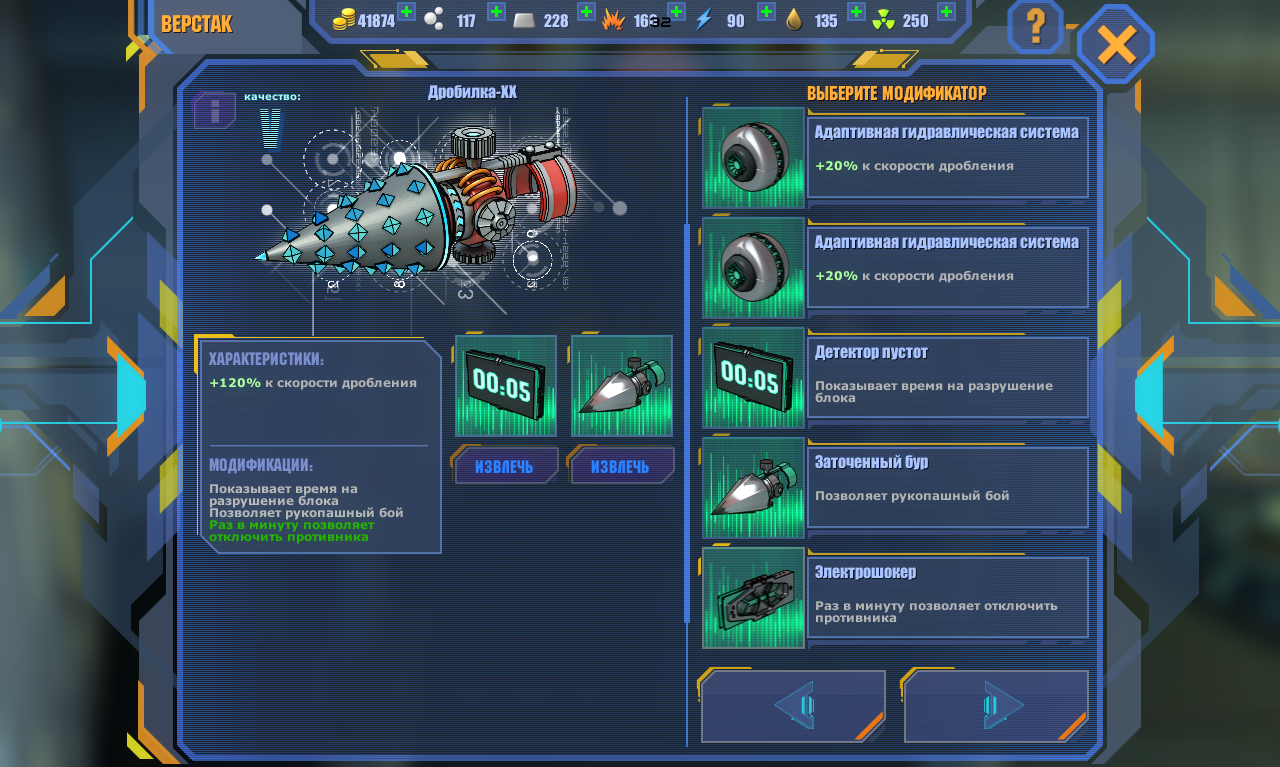
There are also a lot of modifiers, and many of them not only increase the parameters, but also add new mechanics to the game.
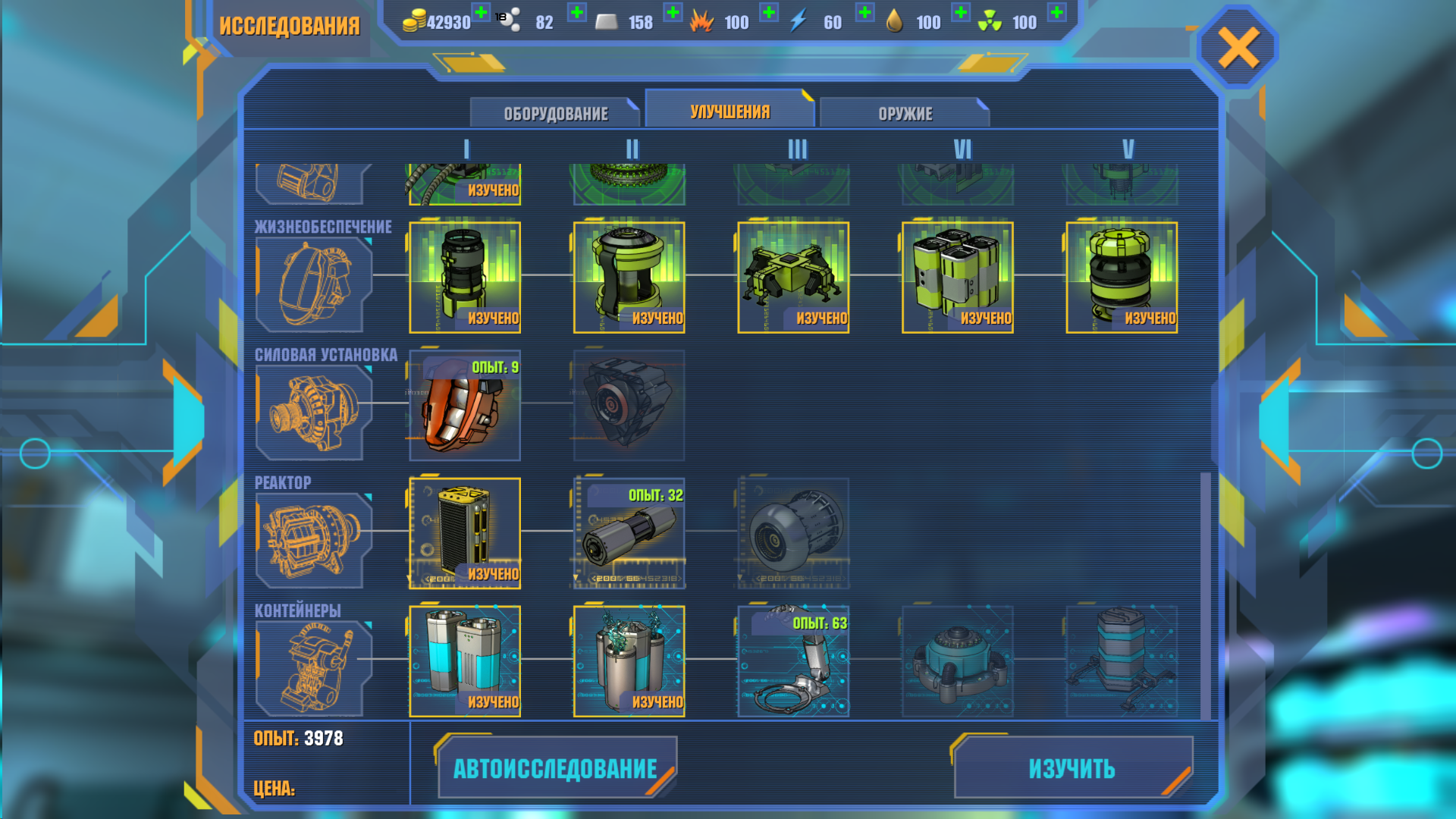
I have already mentioned about the weapon, about two dozen original and about a dozen new bombs on the way (freezing, light, magnetic, etc., intended to fight against our mobs).
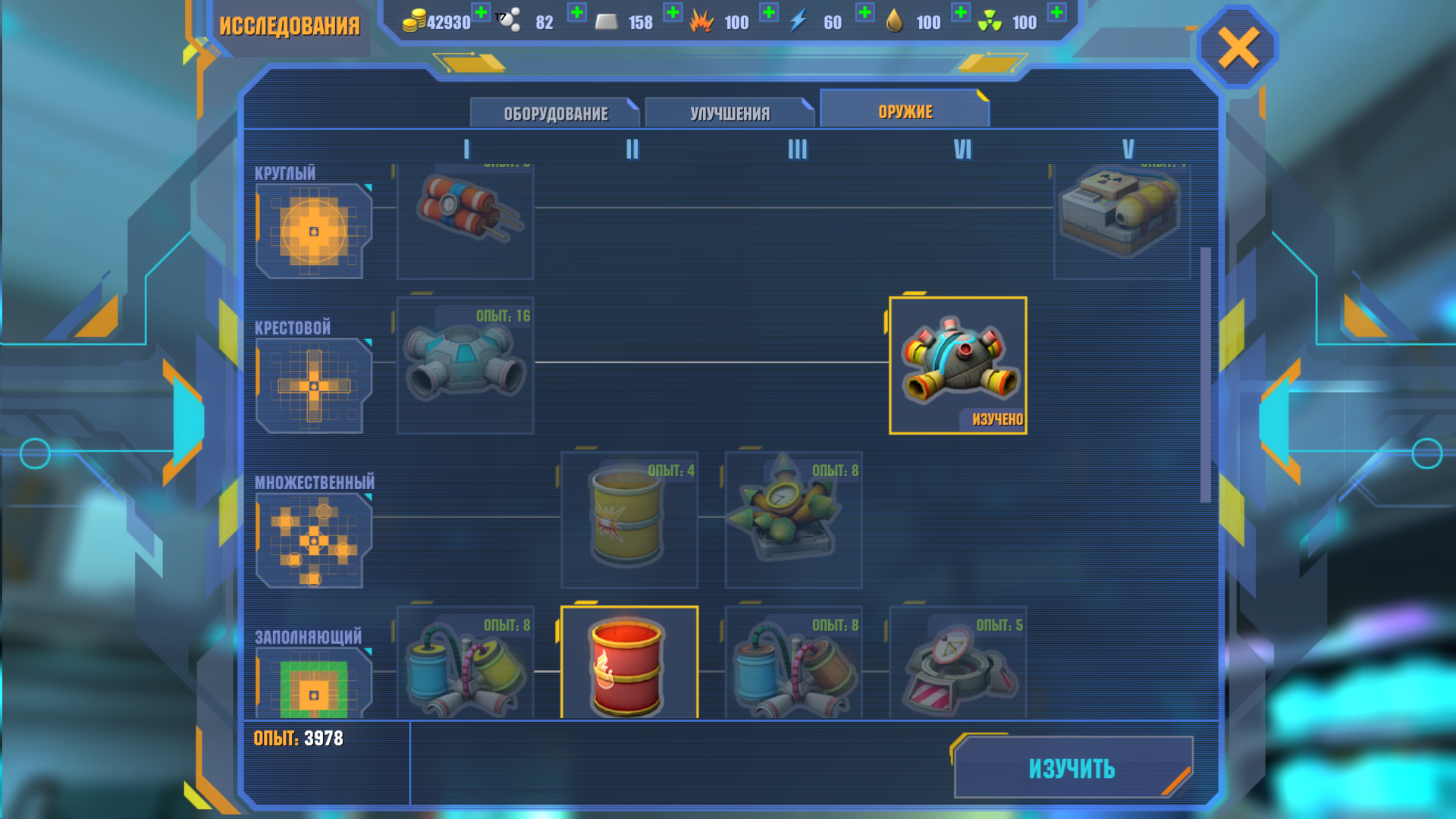
Do you still have little pumping? Then for you the whole underground base, from 15 types of premises, each of which can be pumped up to the 5th level. Here you can develop the extraction and production of resources, get access to shops, combat modes, pvp, explore the schemes of weapons, equipment and modifiers.
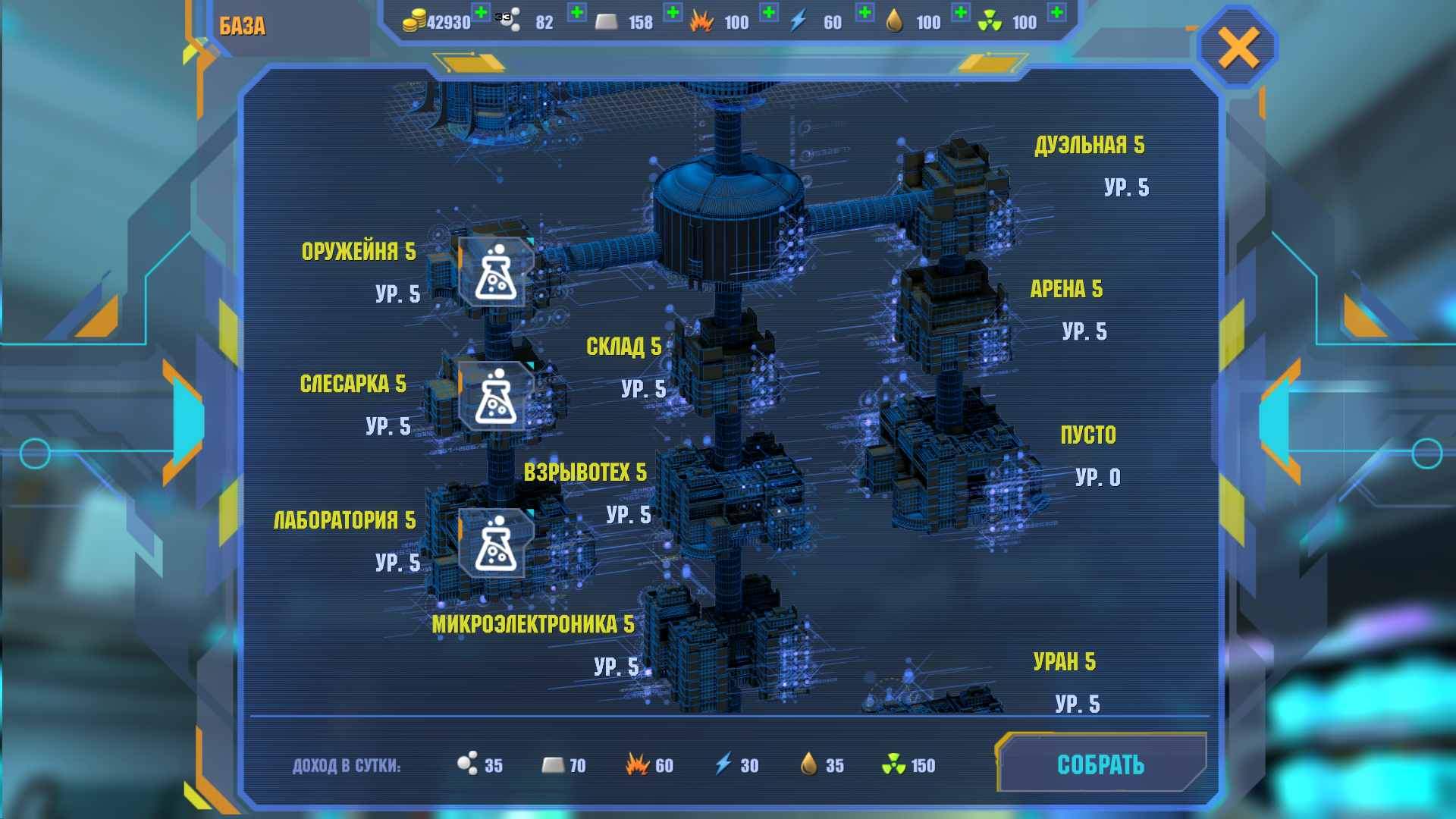
Total:
- 3 classes;
- 6 subclasses;
- 19 skills;
- 49 types of equipment;
- 50 types of modifiers;
- 75 types of base modules;
- 20 types of weapons.
The question of whether we realized it for nothing or not for nothing is open and it is too early to judge this, but the fact that implementation took a lot of time is a fact.
, . .
If you have a person who does not know how to program, draw, model or write music, but wants to take part in the development, then it does not matter. Let him deal with public relations. Let him out of the bushes, like a real paparazzi, watch your work by arming yourself with a long-focus lens and fixing your every word. Let him compile reports for the faithful fans about your current work, publish game screenshots and videos in your VKontakte groups, Facebook, Twitter, and even in instagram. Spread test builds, collect reviews. All this needs to be done throughout the development to know if you are going in the right direction, but no one has time for it. In terms of personnel shortage, each article for your VKontakte group takes your precious time, and after all, fans are such people,who want to receive news if not every day, then at least every week. At one time, we actively led our group, and our wonderful scriptwriter / level designer released a couple of posts a week, but how much time did it take for him? In general, everyone can find a useful lesson.
Council for growth. Conference.
Conferences and various jams are not just parties, but also a place where you can get a lot of feedback from professionals in the gaming field. So if you have the opportunity, then participate in them as often as possible. Personally, because of my place of residence, I am deprived of this opportunity, but for metropolitan developers this is a significant competitive advantage.
The harsh truth. The end of development is only the middle of the road.
Promotion and creation of promotional materials on labor costs is not much inferior to the development itself. Creating an advertising video, game art, game descriptions, advertisements, reviews, mailing and advertising in groups, takes a lot of time working professionals.
Oil. Butterfly Effect.
Much of our life is due to the butterfly effect.
... a butterfly in Africa sat on the nose of a giraffe, the giraffe sneezed ...
... frightened gazelle, gazelle imprinted on rhino ...
... and the rhinoceros blindly ran into the phone booth ...
... somehow called OPEC and said ...
"Immediately increase loot!"
... the price of oil is falling
... and the dollar doubles against the ruble
and here we are looking at how our budget shrinks no worse than shagreen.
Conclusion: if you are counting the budget in rubles, then agree on payment with everyone you can in rubles, and lay out currency items of expenditures with a margin.

Content generation. Is the bet on the player justified?
The original was an excellent map editor. Simple, clear, effective. So even in the prototype a year ago, a similar map editor was present. There was even the ability to upload your own maps to the server and share them. The bet was made on the fact that the players will be able to fill the game content themselves. Create your own interesting levels, share them, etc. It was easy and paid for itself by the speed of level development. However, if the usual game block occupied exactly one cell, was of standard size and was easy to encode with one symbol in a two-dimensional array, then with the addition of decorative objects, the situation changed. They could be installed at any point, in any quantity, change their size and rotation, they could overlap each other, could interact with the player or not. To this, you can add various scenario objects, such as quest triggers, mob generation points and resources, etc. All this had to be made to the editor, to render objects for icons (and these are several hundred objects), to maintain the constant ability to download maps to the server. Together with the complete serialization of the whole environment, the editor took as a result another month or two. Of course, the editor really came in handy for our level designer. There was no need to learn Unity itself. Plus, the system still works. He can easily edit the current scenario map and update it on the server, or save it locally and immediately go through it without making changes to the build. On the other hand, the resulting editor is somewhat monstrous. After teaching the designer the basics of working with Unity, you could also create new levels without your own editor. They would be harder to test, they would weigh more, but the choice of tools would be wider. Baking lighting, fine-tuning effects, and more would be available. Again, later it was even easier to serialize all of this data, although the maps would weigh more and the players would not have access to the editor.
The conclusions are not surprising in general: the complexity of the game mechanics, and in fact the change of the development paradigm, led to the complication of the accompanying infrastructure. And although the players still have the opportunity to create their own content, but because of the increasing complexity of the process, you cannot count on a large number of such players. The editor will probably remain just a regular development tool.
Was this all a mistake? Of course not. But if we immediately chose a different path, the result could have been no worse.
So is a bet on a player justified? It all depends solely on the project itself. Your condo
Something the article turned out too voluminous, but I didn’t even really talk about the technical part. Looks like you have to interrupt. In the following part I will tell about actually technical side of development on Unity. If there are any other questions, then leave them in the comments, I will answer short ones at once, I will try to highlight the rest in the next article.
PS By the way, we passed Greenlight in a week :)
Source: https://habr.com/ru/post/268699/
All Articles